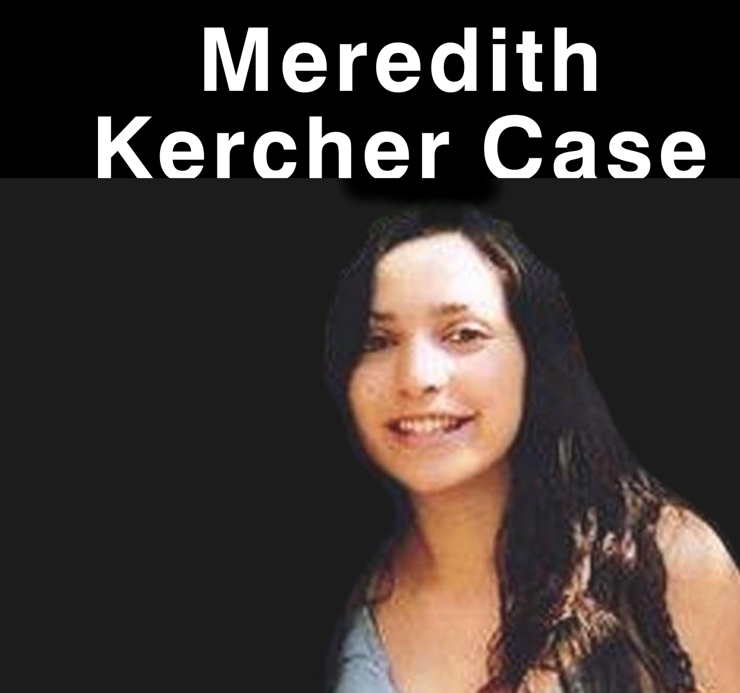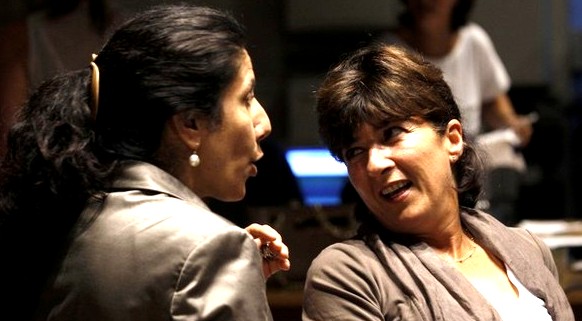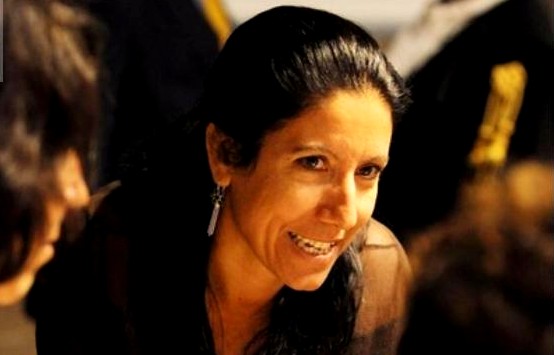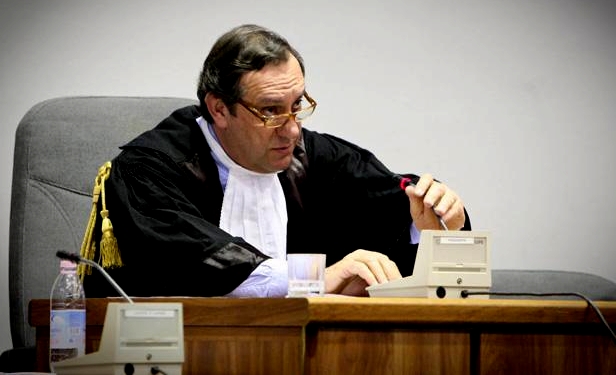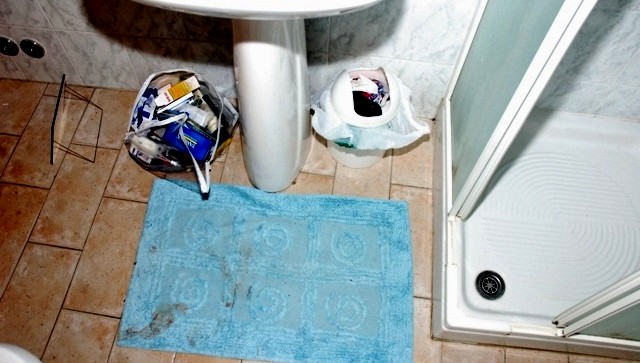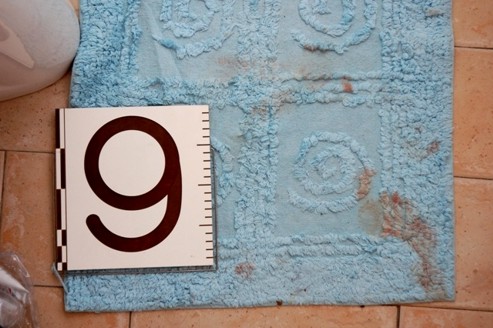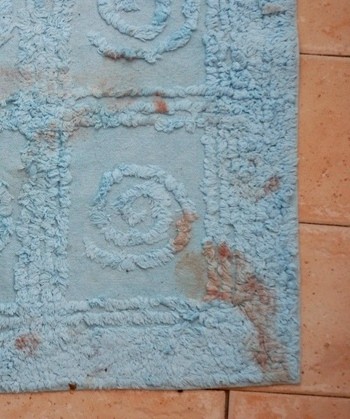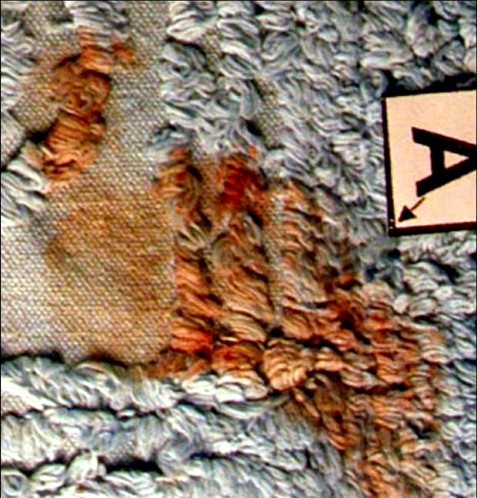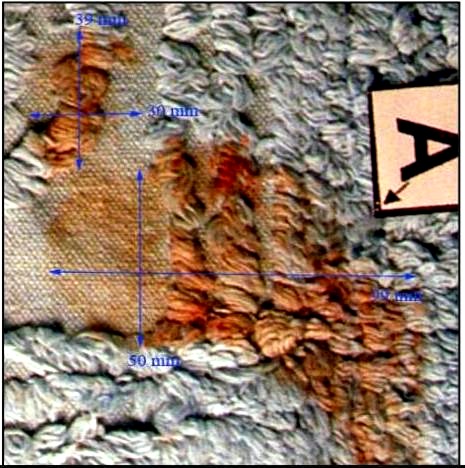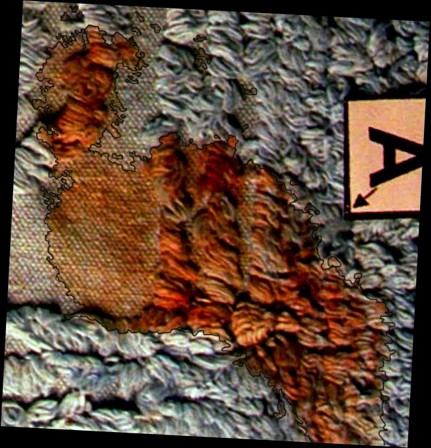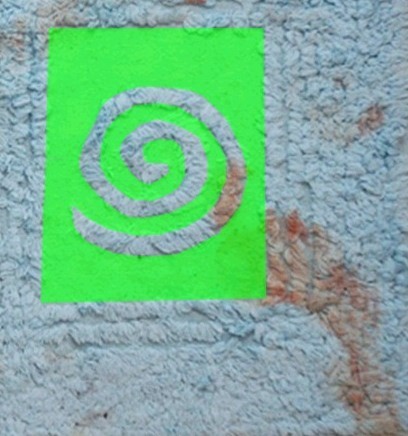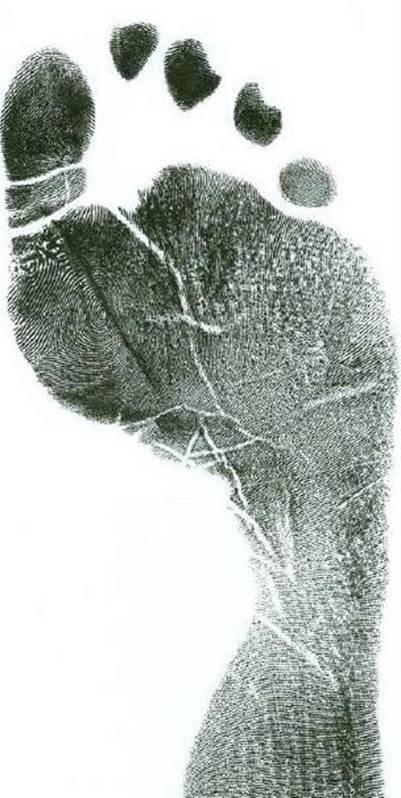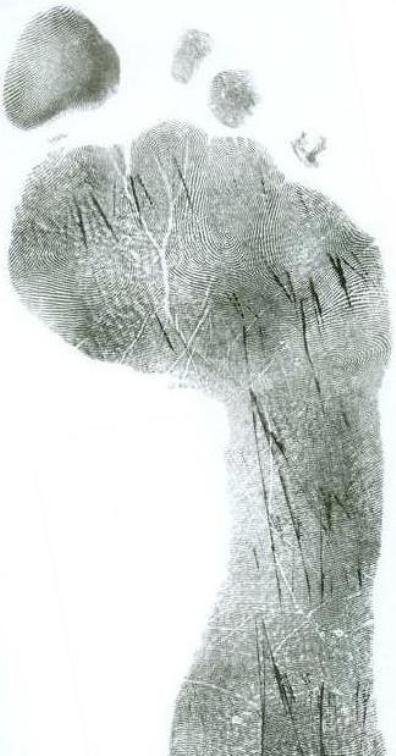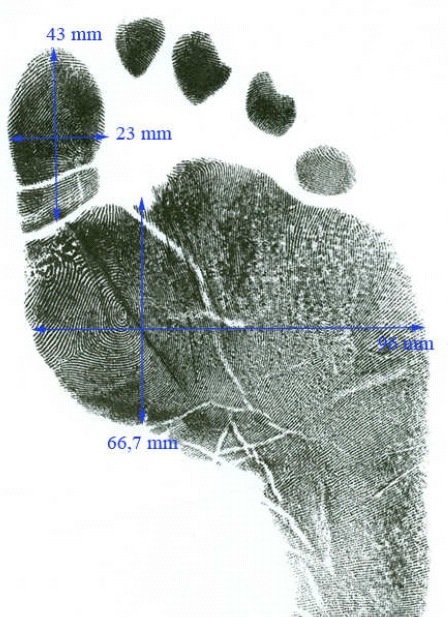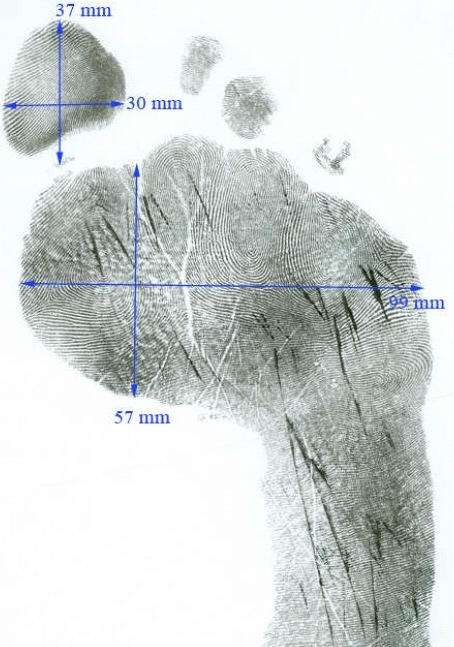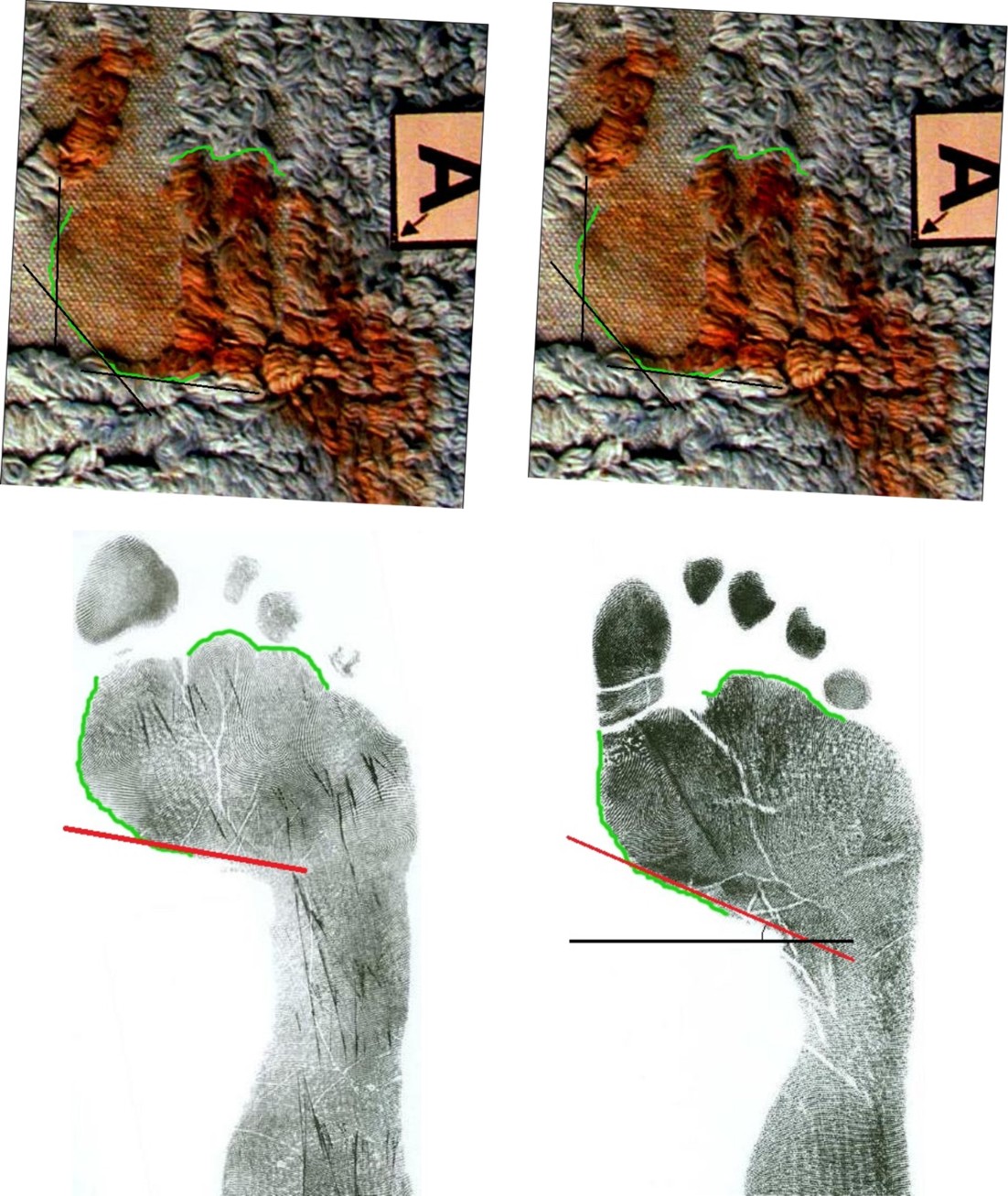
Headsup: The deep expose with associated comments below was first posted by Finn MacCool on 12/20/13. Knox's failed calunnia trial in 2009, failed 1st appeal in 2011, and failed final appeal in 2013 had come and gone. Some 500 zombie misrepresentations had recently reappeared in Knox's English-only 2013 book. See main support documents here and also (vitally) this and this and this.
Category: DNA and luminol
Thursday, April 27, 2017
Multiple Attackers and the Compatibility of the Double DNA Knife (Exhibit 36)
Posted by James Raper
Our YouTube whiz DelPergola’s video of November 2010
Ed note: This evidence area is enormously compelling - but also emotionally difficult. It is why initially we did not publish our translation of the Micheli Report. And why a quarter of the trial was behind closed doors with the media excluded. That well-meaning decision has bedeviled the case ever since, because only the jury and others in court then - including the white-faced and tongue-tied accused pair - were exposed to the full power of the prosecution testimony.
Material from some of my previous posts on TJMK (link at bottom here) was incorporated into my Justice on Trial book. From Chapter 15, this is the second of several posts setting out further material.
Before looking at the forensic evidence, which is the final theme I identified earlier, it will be helpful to take into account the wounds suffered by Meredith, and whether these suggest anything as to the dynamics of the murder, and whether any of them were compatible with the knife recovered from Sollecito’s kitchen, Exhibit 36, called the Double DNA knife because the DNA of Meredith was found on the blade and the DNA of Knox on the handle.
As mentioned earlier the autopsy was carried out by Dr Lalli.
It was observed that there were no significant injuries to the chest, abdomen or lower limbs.
The significant elements in the examination were described as follows :
A fine pattern of petechiae on the internal eyelid conjunctive.
The presence of tiny areas of contusion at the level of the nose, localised around the nostrils and at the limen nasi [threshold of the nose].
Inside the mucous membranes of the lips, there were injuries compatible with a traumatic action localised in the inner surface of the lower lip and the inner surface of the upper lip, reaching up to the gum ridge.
Also found on the lower side of the jaw were some bruising injuries, and in the posterior region of the cheek as well, in proximity to the ear.
Three bruising injuries were present on the level of the lower edge of the right jaw with a roughly round shape. In the region under the jaw an area with a deep abrasion was observed, localised in the lower region of the middle part at the left of the jaw.
Once the neck had been cleaned it was possible to observe wounds that Dr Lalli attributed to the action of the point of a cutting instrument.
The main wound was located in the left lateral region of the neck. A knife would be compatible provided it had one cutting edge only which was not serrated. The wound was 8 cms in length and 8 cms deep. The width could not be measured because the edges had separated due to the elasticity of the tissues both in relation to the region and to the position of the head, which could have modified the width. The wound had a small “tail” at the posterior end. The wound penetrated into the interior structure of the neck in a slightly oblique direction, upwards and also to the right.
Underneath this large wound, another wound was visible, rather small and superficial, with not particularly clear edges, “becoming increasingly superficial until they disappeared”, in a reddish area of abrasions. The knife had penetrated both Meredith’s larynx and the cartilage of the epiglottis, and had broken her hyoid bone. A consequence of that damage is that Meredith would be unable to vocalise, let alone scream.
There was also a wound in the right lateral region of the neck, also attributed to a pointed cutting instrument. This was 4 cms deep and 1.5 cms wide (or long). It had not caused significant structural damage.
The presence of two relatively slight areas of bruising, with scarce colouring and barely noticeable, were detected in the region of the elbows.
On Meredith’s hands were small wounds showing a very slight defensive response. A small, very slight patch of colour was noticed on the “anterior inner surface of the left thigh”. Another bruise was noticed on the anterior surface, in the middle third of the right leg.
The results of the toxicological analyses revealed the absence of psychotropic drugs and a blood alcohol level of 0.43 grams per litre.
Tests of histological preparations of fragments of the organs taken during the autopsy were also performed. They revealed the presence of “pools of blood” in the lungs.
The cause of death was attributed to asphixiation and loss of blood, the former being caused by the latter.
There was nothing in the pathology which confirmed that Meredith had been raped, though we should recall that Guede’s DNA was found on the vaginal swab, though not of a spermatic nature. For Massei this was confirmation that she had been subjected to a sexual assault.
—————————————
There was argument in court as to whether Exhibit 36 was compatible with the main wound. There was no dispute amongst the experts that it could not have been responsible for the wound on the right. The knife had an overall length of 31 cms and the length of the blade from the point to the handle was 17.5 cms. The width of the blade, 4cms from the point, exceeded the width of the right hand wound. The wound on the right was more akin to a pocket knife, or perhaps a flick-knife.
I shall look at the arguments advanced by the defence as to why the knife would not be compatible in a moment, but before that there is a simple logical point as to incompatibility based on measurements.
A knife would only be incompatible if the length of the wound was greater than the length of the blade of the knife, or if the width of the wound was less than the width of the blade. Exhibit 36 was therefore a priori compatible.
On this basis I would also have to concede that a pocket or flick-knife is not a priori incompatible with the main wound, unless (though we would not know) the length of it”˜s blade did not exceed 8 cms.
It should however be recalled that the width of the left side wound was also 8 cms. That is over 5 times the width of the wound on the other side of the neck. The width of the blade on Exhibit 36, 8 cms from it’s tip - and being approximately 3.5 cms wide- was over twice the width of the blade on the “pocket knife”. This fact, and the robustness of the larger weapon, particularly with regard to the observed butchering at the base of the left-sided cut, makes Exhibit 36 a far more likely candidate, in my submission, than a “pocket knife”, and that’s without taking into account Meredith’s DNA on the blade.
We can also enter into a numbers game as regards the experts (8 of them) who opined on compatibility. Massei tells us that Dr Liviero concluded “definite compatibility”, Dr Lalli and Professors Bacci and Norelli “compatibility” whilst “non- incompatibility” came from the 3 GIP experts nominated at a preliminary hearing. The latter were Professors Aprile, Cingolani and Ronchi.
As far as I am concerned “non-incompatability” is not hard to understand. It simply means compatible.
Professors Introna, Torre, and Dr Patumi, for the defence, opined that Exhibit 36 could be ruled out. Their argument was twofold. First, the length of the blade was incompatible with the depth of the wound had the knife truly been used with homicidal intent. Indeed, if it had been thrust in up to the hilt then the point would have exited on the other side of the neck. Secondly, they said that the smaller wound or the abrasions beneath the main wound, mentioned earlier, were in fact caused by the hilt of a knife striking the surface of the neck. Obviously if that were so then the main wound was not caused by Exhibit 36.
Their argument does not consider, because we do not know, what may have been the actual dynamics of the knife strike. We cannot know what was the cause of the underlying wound or the reddish area of abrasions. As to that wound it may have been the result of the knife edge being run across the surface of the skin and the abrasions may have had a different cause in the prior struggle for which there is ample evidence. Hence their argument seems very weak.
We cannot leave the topic without considering that there may have been more than two knives involved. This possibility arises from the evidence of Professor Vinci, for the defence. He considered blood stains that were on the bed sheet in Meredith’s room. These stains very much resembled the outline of a knife, or knives, laid to rest on the bed sheet.
It was Professor Vinci’s contention that the bloody outlines (a dual outline from the same knife he said) was left by a knife with a blade 11.3 cms long, or a knife with a blade 9.6 cms long with a congruent blooded section of handle 1.7 cms long (9.6 + 1.7 = 11.3), and having a blade width of 1.3 to 1.4 cms.
Taking these measurements as read they may seem incompatible with a pocket knife (such as Sollecito had a proclivity to carry) and they certainly are as regards Exhibit 36. It follows, he argued, that one has to infer the presence of a third knife in any hypothesis and if a pocket knife and Exhibit 36 are already accounted for by Knox and Sollecito then a reasonable inference is that the third knife would have to be Guede’s. Professor Vinci’s blade is not incompatible a priori with either of the two wounds.
The problem, and without going into detail on the matter, is that Professor Vinci’s contention and measurements are somewhat speculative depending on what one thinks one sees in the stains. It is rather like reading tea leaves. One could just as well superimpose Exhibit 36 over the stains and conclude that it was responsible for them.
Massei only briefly commented about the bloody outlines on the bed sheet. He opined that the blood stains were certainly “suggestive” but insufficient to establish any clear outlines from which reliable measurements could be established. Clearly then he did not accord any reliability to Professor Vinci’s measurements.
—————————————————-
We can now turn to the issue of whether Meredith’s injuries tell us anything about whether her attacker was a “lone wolf” or not.
Massei believed that Meredith’s injuries lay at the heart of the matter. It seemed inconceivable to him that she would first be stabbed twice and that she would then be strangled. The amount of blood, being very slippery, would make maintaining pressure on her throat difficult. So Meredith was forcibly restrained and throttled first. The hypothesis of a single attacker requires that he continually modify his actions, first by exercising a strong restraining pressure on her, producing significant bruising, and then for some reason switching to life threatening actions with a knife, thereby changing the very nature of the attack from that of subjugation to that of intimidation with a deadly weapon, and finally to extreme violence, striking with the knife to one side of the neck and then to the other side of the neck.
Massei described the first knife blow, landing on the right side of her neck, as being halted by the jawbone, preventing it from going any deeper than the 4 cms penetration. The court considered that this was an action to force Meredith to submit to actions against her will. The same hypothesis could also, of course, in view of the injuries to the jaw, apply as to the lack of penetration with Exhibit 36 on the other side
What surprised Massei about Meredith’s wounds was that in spite of all the changes in approach during the attack she somehow remained in the same vulnerable position, leaving her neck exposed to attack.
Massei paid particular attention to the paucity and lack of what can be regarded as defensive wounds on her hands by comparison with the number, distribution and diversity of the impressive wounds to her face and neck. He found this disproportion to be significant, particularly with regard to what was known about Meredith’s physicality and personality.
Meredith was slim and strong, possessing a physicality that would have allowed her to move around with agility. She liked sports, and practiced boxing and karate. In fact she had a medium belt in karate. She would, had she been able to, have fought with all her strength. How then would a single attacker have been able to change hands with a knife to strike to both sides of her neck, let alone switch from one knife to another? He would have had to release his grip on the victim to do that, unless she had wriggled free and changed position, in which case he would have to subdue her all over again, but this time, if not before, she would be ready.
Since the attack was also sexual in nature, at least initially, how could a single attacker have removed the clothes she was wearing (a sweater, jeans, knickers and shoes) and inflicted the sexual violence revealed by the vaginal swab, without, again releasing his grip? It might be suggested, as the defence did, that Meredith was already undressed when the attack began, but for this to be the case one of three possible alternative hypotheses has to be accepted.
The first is that Guede was already in the flat, uninvited, and un-noticed by Meredith, which can only mean that the break -in was genuine but un-noticed by her. The second is that Guede was there by invitation and that their relationship had proceeded by agreement to the contemplation of sexual intercourse when Meredith suddenly changed her mind, unleashing a violent reaction from Guede. The third is that, having been invited in Meredith then thought that he had left, although he had not.
Having looked at the staging we can surely rule out the first hypothesis. As to the second, it does not fit with what is known about Meredith’s personality and the relationship she had been developing with Giacomo. As to the third it is difficult to imagine that in a small flat Meredith would not have checked before securing the front door and preparing for bed.
Massei found it was highly unlikely that one person could have caused all the resulting bruises and wounds by doing the above, including cutting off and bending the hooks on the bra clasp. The actions on the bra clasp alone would necessitate someone standing behind her and using a knife to cut the straps, requiring the attention of both hands from her attacker, during which time Meredith would have had the opportunity to apply some self-defence. It has to be conceded though that this could have happened when she was concussed, though there is no persuasive physical evidence of a concussive blow, or during or after she had been mortally wounded.
Massei concluded that there was little evidence of defensive manoeuvers on Meredith’s part, which to him meant that several attackers were present, each with a distribution of tasks and roles: either holding her and preventing her from making any significant defensive reaction, or actually performing the violent actions. He concluded that the rest of the body of evidence, both circumstantial and forensic, came in full support of such a scenario. He concluded that two separate knives had been used and that one was from Sollecito”˜s bedsit.
Although, at the trial, the defence had attempted to explain a scenario whereby a single attacker might have been responsible for the injuries, that there had been multiple attackers was not a scenario with which any court, other than the first appeal court presided over by Hellmann, demurred.
Wednesday, June 17, 2015
Major Additions To Meredith Kercher Case Wiki To Provide Complete Impartial Overview in English
Posted by azoza
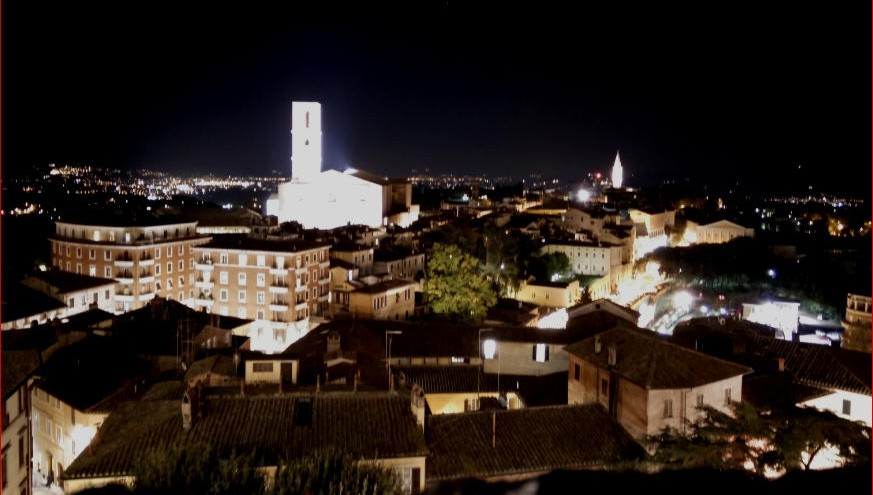
Image is of the very beautiful Perugia at night
Origin and mission
The impartial Murder of Meredith Kercher Wiki began in 2013.
The seed was people discussing how to overcome the flawed Wikipedia article of the case. That article relied on sources like Candace Dempsey, Nina Burleigh and American media. In other words, biased or incomplete sources.
In May 2013, Edward McCall set up the website, with the help of volunteer editors from the Perugia Murder File community. Its mission statement was:
Were Amanda Knox, Raffaele Sollecito, and Rudy Guede responsible for the death of Meredith Kercher? This wiki style site was created by a group of volunteer editors to inform the public about the case, by providing translations of original documents and evidence presented at trial.
This continues to be the aim of the Wiki: to make available documents and translate them properly. Our interest is not selectively posting documents, like the Knox campaign has done. We want to make all the facts available, without bias or selecting. We believe all the facts support the notion that all three defendants are responsible for Meredith Kercher’s murder.
Purpose of this post
The purpose of the article here is to let people know of recent changes to the website.
The Wiki is revised when new documents and translations continue to be received. Existing webpages are tweaked when time allows. Webpages are sometimes changed so information can be better presented. Or the website structure is changed when a significant page is introduced.
For example, a new page listing a lot of evidence was added in November 2014. This page can be directly accessed from the main page. That evidence list page has links to other sections of the website, like “˜wikified’ testimony, for easier reference. More links will be added and more evidence noted as more documents become available.
Major redesigns
The website had two major redesigns earlier this year. The main page was redesigned to provide clearer “˜at a glance’ updates. We did this primarily to keep everyone up-to-date with the March 2015 Cassazione decision. The boxes on the main page also note updates to other parts of the website. Also, we added buttons so any webpage on the site can be shared on various social media.
The other major redesign has been the addition of the “˜file library’.
Completing the picture
For those long familiar with the case, source material had been seriously lacking. There have been large gaps. The Knox campaign has posted some documents, but their “˜collection’ has always been incomplete. As examples:
1) The crime scene photos start at “˜dsc016’. What about photos 1 through 15?
2) No photos of Sollecito’s place, Guede’s place, via Sperandio or elsewhere
3) They posted many Massei transcripts, but not all. They never posted the 2nd day of Knox’s testimony, or the days when the Kercher family and consultants testified.
4) Some Massei transcripts they posted had pages missing.
5) They have posted many defense consultant reports, but few prosecution consultant reports.
6) They only posted a few Hellmann transcripts, but not all.
7) They only posted one Micheli transcript, but not the others.
8) Hardly any depositions.
9) A lot of police reports are still missing.
In the past six months, we have been trying to correct this. We have set up a file library, which will be the repository of as many case-related files as can be gotten. Files will ultimately include documents, photos, videos and audio- whatever is part of the public record of this tragic case. The files are made available as links for downloading. Eventually many will also be “˜wikified’ so anyone can do a word search through the documents. And when time allows, key documents will be translated.
There are thousands of files related to this case - too many to put on one page. A single file page would take forever to scroll and would be terribly confusing. So the library is structured into subsections. The basic idea is “˜nested boxes’. Once you select a section, you “˜drill down’ through pages to get to document links. Then you click “˜back up’ to the higher levels so you can move to other sections.
Some pages have a mixture of links to documents and links to subpages. These will eventually be simplified for clarity.
Not all file library pages have been created. More pages will be required as more files come in. Once the document files (PDFs) portion is nearly complete, pages will be reviewed and the library layout will be tweaked. At that point, when we’re comfortable with all the pages and their names, links will be added to allow browsing across sections or in sequential order. This hasn’t been done yet to avoid redoing a lot of work later.
A directory tree is a strong possibility too.
The seven sections
The library has over 900 PDFs and photos scattered across 7 major sections.
The 1st section
This section Context and people is empty for now. It will have photos of Perugia, the cottage, nearby locales and pictures of the people involved in the case. We are sifting through photos and erasing duplicates. Once that’s done, this section will quickly fill out.
The 2nd section
This section 2007 Investigations has files related to police investigations in 2007, the arrest and crime scene photos and videos. As mentioned, not all crime scene photos and videos have been made public. We hope to gather as complete a collection as possible. Of course, anything showing Meredith Kercher’s body will be censored, in line with the wishes of the Kercher family, and to maintain dignity. In the past 1.5 months, we’ve gotten over 80 depositions of witnesses and other documents related to early investigations. Things like preliminary police reports and police correspondence. Here you can also find phone and prison taps.
The 3rd section
This section Arrest trials has filed related to the cautionary arrest trials. This includes the Matteini court, the Ricciarelli court and the 2008 Cassazione court, presided by judges Gemelli & Gironi. Files include court hearing transcripts, motivation reports and other files pertinent to these hearings. This is missing quite a bit still, but we hope to correct that.
The 4th section
This section 2008 Investigations has files related to police investigations in 2008. While the murder was discovered on Nov 2, 2007, and arrests were made that month, the actual police investigation continued until the following year, finishing in June 2008. Files here include additional phone and prison taps, police reports from Rome and Perugia, additional depositions and other related documents.
The 5th section
This section Statements and writings contains writings and depositions of the three defendants. GKS = “Guede Knox Sollecito”.
The 6th section
This section Trials and Appeals and Reports is the largest section. We may revise or split this section further. Currently it contains all documents related to the main trials. All three defendants took part in the first main trial, the 2008 Micheli court. Micheli indicted Guede and found enough evidence against Knox and Sollecito. After the Micheli court, Guede’s trial path separated from the other two because he chose a fast-track option. So there are 3 subsections: Micheli, Guede trials and Knox + Sollecito trials. The Knox + Sollecito trials page has further subpages for the Massei court, the Hellmann appeals court, the Nencini appeals court. In this section, one can find court transcripts and reports, correspondence or depositions introduced during court proceedings. So a lot of files.
The 7th section
This section is extra material.This will contain documents, photos and videos indirectly related to the case. Things like interviews, documents on forensics, lab manuals, crime scene analyses, documentaries, related trials like the police calumnia trials, etc.
A few quick notes:
1. There are many versions of the Massei motivations report on the Internet. Most are missing two pages. Another version comes in four parts. We edited ours so this is a complete version with the “˜famous’ missing pages.
2. Similarly with the Borsini-Belardi motivation report. Many versions out there, most of them improperly OCR’ed, with sections missing. Our version is a scan version, not the OCRed one.
3. As noted before, recent additions include a lot of depositions of witnesses taken in the first week of police investigation. You can find these in the “2007 police work” page.
4. Police summaries of the crime scene surveys, and fingerprint reports, are at the bottom of that same page.
5. There’s a PDF containing a “˜5 volume’ police photo report. This PDF has photos of Via Sperandio currently not in the crime scene photos. But certainly those photos are part of the same Nov. 2007 crime scene photo survey. Anyway, you can find it in the Crime Scene page at the bottom. It’s called Photo-photographic-file-censored. We edited out pictures of the body, to preserve dignity of the victim.
6. Towards the bottom of the “2008 investigations” page, we recently added two police charts, and the first “shoeprint report” by Rinaldi & Boemia, which has more data on shoeprints. Their second report concentrated on the footprints.
7. We have the Cassazione March 2015 dispositivo. We will be posting that along with other documents shortly.
In conclusion
The file library is an ongoing thing. We hope to make real progress here, so everyone can look at all the facts of the case, not just a few picks. A bright light is needed on as much material as is possible to offer, in honor of Meredith Kercher, the victim.
When we post a new file batch, we add an update note on the Wiki home page.
The Meredith Kercher Wiki is committed to being the essential record of all publicly available documents and testimonies about the case, to benefit the general public and the media. Please circulate this widely, and check in regularly. There are more changes to come.
ADDED 12 JULY
On 2007 Investigations: Police work page
2007-11-03-Log-cellphone-KercherM-English.pdf
2007-11-03-Log-cellphone-Sollecito.pdf
2007-11-07-Log-landphone-Sollecito.pdf
2007-11-27-Police-deposition-Capezzali.pdf
On 2007 Investigations: Arrests page
2007-11-07-Prosecutor-notice-Request-to-validate-Arrest-Knox-Lumumba-Sollecito.pdf
On Arrest trials page
2008-01-21-Testimony-Bernaschi-Sollecito.pdf
2008-05-15-Motivazioni-Matteini-reconfirming-cautionary-arrest-Knox.pdf
On Arrest trials: KSL: Matteini trial page
2007-11-08-Testimony-Matteini-Knox.pdf
On Arrest trials: KS: Ricciarelli trial page
2007-11-30-Motivazioni-Ricciarelli-Arresto-Appello-Knox-Sollecito.pdf (forever missing Ricciarelli report)
On 2008 Investigations page
2008-11-08-Deposition-Monacchia.pdf
On Trials: Micheli court page
2008-09-16-Testimony-Summary-and-Rulings-Micheli.pdf (first Micheli hearing)
2008-10-27-Report-Fioravanti-Vodaphone.pdf
On Trials: KS: Massei and Cristiani trial page
2009-11-20-Closing-arguments-Mignini.pdf (forever missing)
2009-11-21-Closing-arguments-Comodi-Knox.pdf (forever missing- Comodi describes 3D reconstruction)
On Trials: KS: Hellmann and Zanetti trial page
2010-12-11-Testimony-Lawyers-Knox-Parisi-Maori-Ghirga-Vedova.pdf (missing Hellmann hearings)
2010-12-18-Testimony-Costagliola-Comodi-Perna.pdf
2011-01-22-Testimony-Lawyers.pdf
2011-03-12-Testimony-Mandarino-Pucciarini-Ciasullo-Bevilacqua-IniG-IniR.pdf
2011-03-26-Testimony-Brughini-Curatolo-Lucarelli.pdf
2011-05-21-Testimony-Napoleoni-Conti-Vecchiotti-Knox.pdf
2010-12-11-Court-doc-Zanetti-case-review.pdf
On Trials: KS: Nencini and Cicerchia trial page
2014-01-20-Testimony-Maori-Crini-Pacelli-Fabiani-Perna-Maresca-Donati-Colotti.pdf (missing Nencini hearing)
On Trials: Knox and Sollecito trials page
2015-03-30-Sentenza-Cassazione-Dispositivo-Knox-Sollecito.pdf (sentence, not motivations report)
Sunday, February 15, 2015
Sollecito v Italy & Guede: My Subtitled YouTubes Of Rudy Guede’s Interview with Leosini
Posted by Eric Paroissien
Saturday, November 29, 2014
The PMF/TJMK Master Evidence List: First Of Our Projects To Make The Final Picture Whole
Posted by Our Main Posters
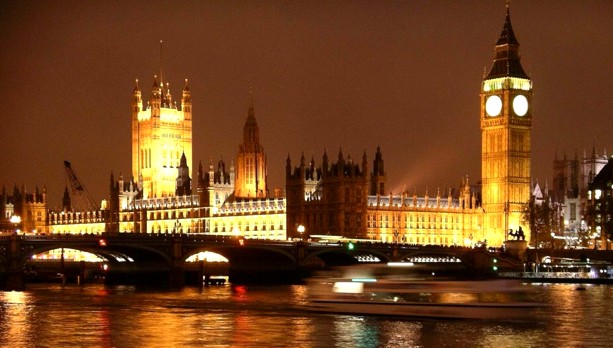
High-achiever Meredith Kercher was born less than one mile south of this famous London landmark
Building An Evidence Mountain
There are really three pictures, not just the one, still to be fully made whole.
- That of Meredith. We believe a family site will soon add to the fine book published by Meredith’s dad.
- That of all of the evidence the court acquired in 2009, which is the sole picture the Italian citizenry takes seriously.
- That of the misleading campaign by the Knox and Sollecito PR shills, leaving some in the UK and US misled.
The Master Evidence List is a key part of the second picture and there are several other media-friendly pages still to come.
Please click here for more
Wednesday, October 22, 2014
The Hundreds Of DNA Samples Taken And Analyses Done, Shown In Table Form
Posted by Olleosnep
1. Even Excluding DNA, There’s Massive Evidence
The DNA Spreadsheet will open using Microsoft Excel or alternatives such as the free OpenOffice. Please note the table is very wide.
Contrary to foolish claims elsewhere, there’s a great deal of evidence implicating not only Guede but also Knox and Sollecito in the brutal murder of Meredith Kercher.
The bulk of the evidence is circumstantial, and encompasses different categories of evidence, such as: wounds sustained by Ms. Kercher; ear and eye witnesses; footprints; shoeprints; fingerprints and lack thereof; blood patterns; evidence that Ms. Kercher was moved after she died; misplaced items in her room and in the cottage; evidence of partial clean-up; cellphone records; computer evidence; evidence of staged break-in; lack of evidence of actual break-in; statements by all three defendants; lack of alibis; lies by Knox and Sollecito; etc.
A lot of the most critical evidence has been repeatedly reviewed by many different judges involved in the case, from Judge Micheli to Judge Nencini, and led to the unanimous verdict at trial now confirmed by Appeal Judge Nencini.
2. The Massive DNA Evidence Is Equally Conclusive
We have carried nearly five dozen DNA posts previously on the Scientific Labs work in 2007-09, the discredited judges’ consultants work in 2011, and the Carabinieri Labs work in 2013.
They go to prove that some of the most damning evidence comes from the DNA traces found on hundreds of samples tested by the Forensic Genetics department of the Italian Scientific Police squadron in Rome. The department was presided over by the biologist Dr. Stefanoni at the time [seen above left with Prosecutor Comodi] who acted as the department’s principal technical director.
The results of Dr. Stefanoni’s work were collected in several reports issued by her lab during the 2008-2009 investigation and trial phases. Of these reports, two reports in particular comprise a “˜survey’ of the work performed by her lab at the time: the “Genetic Tests” report (GT), and the “Stato Avanzamento Laboratorio” report (SAL). Both reports are available on the Meredith Kercher Wiki.
These two reports are notable for highlighting the large quantity of testing done and the significant number of objects and items sampled. In addition, the reports not only look at items with blood traces, but also traces of skin cells, feces, semen, and above all, hair traces, an aspect of the evidence that has been largely glossed over in the testimony and in the motivation reports.
3. For The First Time A Complete DNA Roadmap
In order to better understand the extent of the work and types of the tests performed, I have taken the data that can be gleaned from these two reports and placed them into a single spreadsheet, in order to create a kind of “˜database’ of the testing and analyses done.
This spreadsheet uses the GT report as a basis, followed by additional information obtainable from the SAL report.
The spreadsheet is basically a list of each sample, object and/or test done by Dr. Stefanoni’s team. These include tests done for DNA analysis, testing done for Y haplotype analysis and hair sample analysis. In the SAL report, it is shown that a few samples were tested multiple times. The list also includes some objects which were not analyzed at all, or were only analyzed up to a point.
It should be noted that there are a few difficulties with the reports. The GT report references an associated photographic report that has not been made available. The GT report is also missing a couple of pages and the descriptions of the results are at times inconsistent. Other times it can be tricky to follow exactly what tests were done. Because the report is a black and white scan of an original likely printed in color, some of the information in the tables is difficult or impossible to read. And some traces are missing result tables altogether.
The SAL report is also incomplete. The luminol samples at the cottage and all the samples taken at Guede’s apartment are missing, as are other samples. The scanned pages in the PDF are out of order, making cross-checking with the GT report tedious. The SAL report does not have all the test data indicated in the GT report. For instance, the human antibody tests noted in the GT report are not indicated in the SAL report. The data in the SAL report is often not as complete as one might think. As an example, all hair samples were logged and assigned a sample number. But those hairs that had no DNA extracted, do not have a date of when they were analyzed. Presumably they were all analyzed as a set for each item, given that the sample number is frequently numerically sequential (i.e. 47084, 47085, 47086, etc.). But it’s not possible to say with certainty when the hairs were reviewed from the report.
Nevertheless the GT and SAL reports do have significant information that is of interest to the case. Hence the spreadsheet.
4. Some Guidance For The Use Of The Spreadsheet
Spreadsheets can be useful for presenting various pieces of data together “˜at a glance’. But the real power of spreadsheets for this type of data is that rows can be sorted in order to group similar pieces of data together, allowing one to get a overview of subsets of data.
So, for instance, if one wanted to order all the rows by “˜sample number’ to see the sequence of how they were processed in the lab, one need only highlight all the rows (done by clicking on row number 5, holding down the “˜Shift key’ and paging down to the bottommost row), then go to menu option “˜Data’ and then “˜Sort’ and select the column or columns to sort by- “˜AF’ in the case.
Or perhaps one wants to sort by “˜DNA yielded’ and “˜building’ to see where someone’s DNA was found. Simply select all the rows again, select the menu option “˜Data’ and then “˜Sort’, and select the first column as “˜DNA yielded’ (or column AD), then select as the second column as “˜building (or column F).
To return to the original order, select all rows again and sort on column A.
Note that the first four rows in the spreadsheet are “˜locked’, in order to allow the column headers to be always visible. If one wants to unlock these rows, select the whole spreadsheet by clicking on the upper left corner of the window where the column header labels and row numbers meet. Once the whole spreadsheet is selected, go to “˜View’ option and select “˜Unfreeze panes’. For Excel version 2007 and higher, click on the little arrow to the right of “˜freeze panes’ button on the menu bar, and there will be the option to unfreeze panes.
If one is handy with Access, or any other database program, it should be possible to import the spreadsheet into that database program, allowing one to perform more powerful “˜queries’.
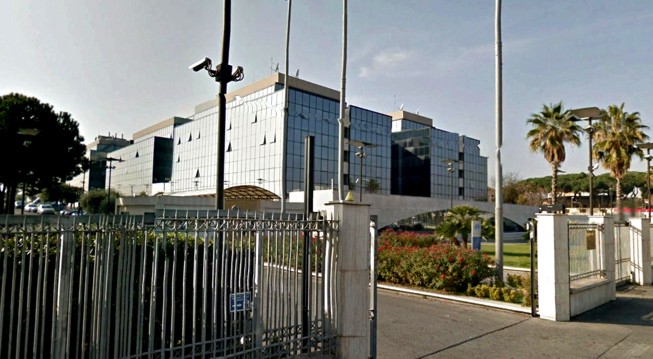
The Rome headquarters of the Scientific Police which work closely with the FBI
5. Explanations Of Some Of The DNA Data
The data in each column was obtained directly or indirectly obtainable from the two reports by Dr. Stefanoni’s team.
1) Column “˜A’ allows one to resort rows to their original order, which is based on the order of the “˜item number’ noted in the GT report.
2) “˜Item number’ refers to the actual piece of evidence, whether an object sampled onsite or an object that was bagged and taken to the lab, as noted in the GT report.
3) “˜Original item label’ is data provided in the first pages of the GT report, as a way to tie the evidence item back to evidence markers used at the crime scene, and visible in some of the crime scene photos.
4) “˜Page in attached photo report’ indicates that there is an adjunct “˜photo report’ Dr. Stefanoni provided that has not yet been released, and likely has photos of the evidence items “˜in situ’. This information is also noted in the beginning item lists in the GT report.
5) “˜Sample date’ is based on the dates noted in the beginning list in the GT report, indicating when the evidence item was sampled or taken from the crime scene. This is sometimes difficult to read, due to the fact that the report was apparently printed in color and the black and white scan hides or obscures some text and graphics.
6) Columns F-K are location and object data, obtainable from the descriptions in the GT report, especially the first pages that provide a list of where evidence samples were obtained. I broke this data down into various categories to allow different possibilities of grouping the data.
7) “˜Sample obtained’ indicates the type of biological substance that was assumed to contain DNA. This was first obtained from the GT report, and later corrected with the data from the SAL report, which has a more consistent description of what the sample was assumed to be.
8) Columns M through AC list data either directly reported in the GT and SAL reports, or interpretable from them. Column M notes if an item was analyzed or not. In the GT report, unanalyzed items are noted in the beginning list as “˜not analyzed’ though not consistently. In the SAL report, they are noted as having 0 samples.
9) “˜Trace number’ was obtained from GT report, though on a few occasions, the actual number is not clear. Note that the number “˜starts over’ for each evidence item. Sometimes the trace number is sequential, independent of whether it is blood or hair or skin cells. Items having the most traces are those that were “˜heavily’ sampled, including Sollecito’s sneakers, the duvet, Ms. Kercher’s sweat jacket, her jeans, the kitchen knife, the kitchen sponge, etc.
10) “˜Additional trace info’ is additional information noted from both reports about a specific sample.
11) Column P “˜revealed in luminol?’ indicates with a “˜yes’ those samples obtained during luminol analysis. What often gets overlooked is that luminol analysis was performed not only at the cottage, but in Sollecito’s car, Sollecito’s apartment and Guede’s apartment. Notable here is that 14 different samples were obtained from luminol analysis at Sollecito’s apartment. While the DNA data yielded was meager, what is important is not the actual data yielded, but the number and location of samples investigated, including samples from door handles, and different locations like the bathroom, bedroom and kitchen. There was certainly a suspicious amount of blood, bleach or turnip juice at Sollecito’s place!
12) “˜Date of extraction’ comes from the SAL report, though, as mentioned above, it is not consistently reported for every trace or sample analyzed. This indicates when DNA processing occurred on a sample. This column is important to look at when discussing the issue of lab contamination. If one performs a sort on this column and on the “˜sample number’ column, one can clearly see that samples were processed in batches, often a week or two weeks apart. So for instance, claims that the sample 36B happened due to contamination at the lab is really not possible, given that Ms. Kercher’s DNA was analyzed one week earlier (11/5/07 and 11/6/07) and sample 36B is the only sample to contain Ms. Kercher’s DNA from all the samples analyzed on 11/13/07. Similarly, Sollecito’s DNA and Guede’s DNA are only found once each of all the items analyzed on 12/29/07, yet the last time Sollecito’s DNA had been analyzed was on 12/17/07, 12 days earlier. So the likelihood of lab contamination seems extraordinarily small, just from the dates of when samples were analyzed.
13) “˜TMB test positive’ was originally obtained from the GT report. Again because that report is likely in color, a number of tables have either missing graphics or are missing tables altogether. Fortunately the SAL report has duplicated this data consistently.
14) “˜Human antibody test positive?’ is obtained from other tables in the GT report, almost always paired with the TMB table. In some cases where the table data is illegible, I’ve placed a “?” in front of an assumed result. Curiously, this test is not shown in the SAL report.
15) “˜Cat antibody positive?’ is from the GT report, shows that the basement apartment blood samples were all made a by cat, which Dr. Stefanoni comments on in her Massei testimony.
16) Apparently they also ran “˜dog antibody’ testing as well, as is noted in the GT report.
17) “˜DNA extraction done?’ indicates if a decision was made to extract DNA. This was inferred from the GT report. Notable here is that even with samples having cat antibodies, Dr. Stefanoni does the DNA extraction anyway to make sure no human DNA is in the sample.
18) “˜Quantity extracted’ comes from the SAL report. This refers not to the amount of DNA extracted, but specifically to the amount of liquid (50, 100 or 150 microliters) filtered through the Qiagen Bio Robot EZ1 machine. This machine actually filters or purifies the sample, removing all other biological materials like cells, bacteria, etc. leaving only actual DNA molecules which can then be processed. This extraction process is also the quantification process, where from a 50 microliter sample a certain amount of DNA is found and quantified.
19) “˜Human DNA found during quantification’ was inferred from the GT report. It should be noted that for Dr. Stefanoni’s team, DNA analysis involved finding DNA useful for comparison. This means that Dr. Stefanoni was not looking for a sample of any human DNA, but a sample sufficiently “˜complete’ to be able to compare it with others samples. So it was likely often the case that a trace might have snippets and pieces of DNA, but these pieces were either too small or too fragmented to be useful for any profile comparisons. So “˜No’ in this column means not so much that no DNA was found at all, but that no DNA was found that could be useful for comparison.
20) “˜Decision to amplify and analyze’ was obtained from the GT report. Sometimes it is explicitly mentioned in the description of the results in the GT report. Other times, it can be inferred from the lack of tables.
21) “˜Concentrate sample with Speed VAC 110’ means that where “no human DNA was found” (i.e. when no DNA was found sufficiently complete or in sufficient amounts useful for comparison), Dr. Stefanoni decided to process the sample further in an effort to “˜bring out’ whatever DNA there might be. This was done using a “˜concentrator’, which dries the samples and vacuums them, thereby reducing sample fluid to make any DNA present more easily found by the subsequent DNA processing equipment.
22) “˜STR amplification’ is the DNA copying process whereby any DNA found is copied millions of times to obtain samples that can be adequately rendered by capillary electrophoresis. The process Dr. Stefanoni used is described specifically in the GT report for evidence items 12 and 13.
23) In some cases “˜Y chromosome amplification’ is also done. While this may be done at the same time by the same machine, I took any Y chromosome amplification to be a separate test, since per the GT report, it sometimes yielded different results. In a few cases, it is not clear from the GT report if Y chromosome amplification was done on only one sample, or on all the samples of an evidence item. In those cases, I assumed all the samples.
24) “˜Capillary electrophoresis’ is where DNA is rendered through a chemical/electrical process that tags DNA particles with fluorescence. These fluoresced particles are then read by the software of the machine and mapped onto a graph that shows DNA particles as “˜peaks’, which are an indicator of quantity of DNA found. The software of the machine then produced graphs of the peaks obtained and it is these graphs that Dr. Stefanoni and her team used for profile comparison.
25) “˜DNA yielded’ is what is indicated in the GT report and is based on Dr. Stefanoni’s comparison of the DNA profile(s) shown by capillary electrophoresis to index DNA samples she had of Sollecito, Lumumba, Guede, Knox and Ms. Kercher.
26) “˜Egram number’ is taken from the GT report.
27) The “˜sample number’ was taken from the GT and further completed by the SAL report, which has the sample numbers for all samples, whether they were analyzed for DNA or not. The sample numbers are useful for indicating what was happening at the Dr. Stefanoni’s lab. As an example, if one does a sort on column Q (Date of extraction) and column AF (sample number) one can see that between 11/5/07 and 11/6/07, there is gap of 129 samples that were likely performed for another case. The last sample analyzed on 11/5/07 was 47082, and on 11/6/07, the next sample number is 47211. So presumably her lab ran 129 additional DNA tests on samples related to other cases between these two runs. Generally the sample numbers increase sequentially by date, but there are a few exceptions. One in particular is sample 47821, which appears as the last sample on 11/23/07, though samples starting on 11/26/07, three days later, start with sample number 47711. This implies that samples were probably numbered in batches (by sticking numbered labels on tubes or bags) and not necessarily right before extraction or other machine processing was done.
28) “˜Compatibility notes’ are extra comments noted by Dr. Stefanoni in the GT report.
29) “˜Likely substance containing DNA’ is interpretable from the GT and SAL report and the results of the testing done.
30) Finally there are columns related to hair analysis. “˜Type of hair’ comes from the SAL report, and it is sometimes, but not consistently or legibly, noted in the GT report.
31) “˜Hair color’ provides a description of the hair color. Notable is that the hair description is quite consistent, with black, blonde, chestnut, light chestnut, red chestnut being the more significant categories. This is available in both the GT and SAL report and both reports match.
32) “˜Hair length;’ is obviously the length of hair analyzed. I’m not sure how this was done since the machinery used is not indicated in either report. Again, this is in both reports, and again the data matches in both reports.
33) “˜Hair width’ is the diameter of the hair in micrometers, and is available in both reports.
34) “˜Hair marrow’ is found only in the SAL report, and presumably describes the condition of the very core of the hair.
35) “˜Hair end condition’ indicates whether the end of the hair is “˜cut’, a “˜point’, frayed or otherwise. This is found in both reports.
36) “˜Bulb phase’ relates to the particular phase of hair growth, with DNA apparently present in the hair bulb only during the initial growth phases of the hair. This too is found in both reports.
37) “˜Hair remarks’ are any comments related to hair samples.
38) Lastly, the “˜remarks’ column contains my notes on a particular sample or test, indicating discrepancies or explanations of what I was able to understand.
As noted above, the SAL report does not contain data for all the samples. Per Dr. Gino’s testimony in the Massei trial on 9/26/09, additional SAL sheets were apparently released that indicate that TMB tests were done on the luminol samples at the cottage and that these tests were negative. However it should be noted that TMB is less sensitive than luminol, so it is possible that a luminol sample could be in blood, which however is too diluted to be registered by a TMB test.
6. More Commentary On the DNA Extracted From Blood
1) DNA is only found in white blood cells, not red blood cells
2) The luminol reacts with the iron in red blood cells, not white blood cells
3) Red blood cells outnumber white blood cells by roughly 600 to 1
4) Even if DNA is found it may be not usable for comparison
So just because there is a positive luminol or TMB result does not mean that DNA can be found.
7. More Commentary On The Resulting Statistics
At the bottom of the spreadsheet are some interesting statistics, which I won’t reiterate here, except to note a few things.
a) 227 different objects or site objects were sampled/ obtained for analysis. 30 of these were not analyzed at all. From the remaining 197 objects and site objects sampled, 484 separate tests were set up for analysis, with 93 of these consisting of hair analysis. Of these 484 tests, 193 of them yield DNA data useful for comparison (40%).
b) Of the 193 tests that were “˜successful’, 100 tests yielded DNA compatible only with Ms. Kercher’s DNA (over 50%- again keep in mind their may have been other DNA but it may have been too small or too fragmented to be useful for comparison). Nine additional tests (comprising seven samples) yielded DNA compatible with Ms. Kercher’s DNA mixed with either Knox’s, Guede’s or Sollecito’s DNA. 27 tests had DNA compatible with Guede’s DNA; 18 tests had DNA compatible with Knox’s DNA; 11 more tests had DNA compatible with Sollecito’s DNA. Nine other tests yielded DNA compatible with a mixture of Knox’s and Sollecito’s DNA. 17 tests yielded DNA of unknown men and women (i.e. unmatchable by Dr. Stefanoni), and two tests were of samples obtained from Lumumba.
c) Of the nine tests yielding Ms. Kercher’s DNA mixed with others, five of these yielded DNA compatible with a mixture of Kercher’s and Knox’s DNA. They were all samples found in blood or potential blood- notably: three in the bathroom, one on the corridor floor in a luminol revealed bloody footprint, one in a luminol revealed blood stain in Romanelli’s room.
d) Returning to the discussions about contamination, it is notable that, whether the contamination occurred during site collection or in the lab, one might expect to find bits of contamination occurring here and there over 193 tests. Yet nearly all the arguments involve contamination about two samples, out of 193 tests. Over 50% of the tests that had useful DNA yielded Ms. Kercher’s DNA. If site collection, transport and/or lab procedures were so poor, one would expect to find Ms. Kercher’s DNA in other places as well. Yet very few samples have her DNA mixed with others, and conversely, very few other samples have other mixed DNA. Only nine samples have mixes of Sollecito and Knox’s DNA, eight of which were all obtained at Sollecito’s apartment or from Sollecito’s things (including a pocket knife), and one was obtained from a cigarette butt at the cottage. If contamination was so rampant, why does it occur on only two samples out of 193, (and curiously only on the two most damning samples)?
e) Continuing along the same lines, 118 samples were obtained from Sollecito’s apartment. Of these, 49 were not analyzed, (many were hairs not having bulbs in the right phase). Of the remaining 66 samples that were analyzed, only one, the one the blade of the kitchen knife, had Ms. Kercher’s DNA. And 41 yielded no usable DNA. So if there was contamination, or worse, direct framing of evidence by the lab, certainly there would be more of Ms. Kercher’s DNA amongst those 66 samples, in order to achieve an ironclad case. Yet there is only one sample out of 66 that had Ms. Kercher’s DNA.
f) Similarly, 224 tests were done on objects taken from the upper apartment. Of these 56 were not analyzed for DNA and an additional 61 that were analyzed, did not yield anything useful. Of the remaining 107 tests, only 3 had Sollecito’s DNA (a trace on the cigarette butt, and a trace on the bra clasp having Sollecito’s DNA as well as his Y chromosome.) Surely if there was rampant contamination or worse, direct framing of evidence, one would expect to find more of Sollecito’s DNA in Ms. Kercher’s room. Yet only one sample had his DNA and Y chromosome- the bra clasp.
g) Conversely, it is rather odd that Sollecito’s car was sampled in 16 locations (actually 19 samples were taken but only 16 analyzed), and none of those samples revealed his DNA. Did he ever drive his car?
8. And Finally More Commentary About The Hairs
Guede had black hair. From photos of Nov 2, 2007, Knox had blonde hair and Sollecito had chestnut to light chestnut hair. Meredith Kercher had chestnut to reddish chestnut hair.
93 hairs were found and analyzed. Seven of these were either animal hair or fibers. The remaining 86 hairs were, per the SAL report, all human. Seven of these hairs were black in color. Of the seven, six were short (4 cm or less) and one was long. Of the six short black hairs, four were found on the duvet covering Ms. Kercher, one was found on her mattress cover, and one was found on a sponge (containing fourteen other hairs) at Sollecito’s apartment. It is very likely these short black hairs were Guede’s, and if so, how it one of his hairs get on a sponge at Sollecito’s apartment.
Similarly, 21 blonde hairs were found, ranging from 4 cm to 20 cm. Of these, fifteen were found at Sollecito’s apartment, either on a sponge in the kitchen, or on a sweater. The other six were found at the cottage, with three being found on the duvet, one found inside the small bathroom sink, one found on a mop, one found on Ms. Kercher’s purse and one found on Ms. Kercher’s mattress cover.
Assuming the blonde hairs were Knox’s hair, it is difficult to imagine how they might wind up on Ms. Kercher’s purse and mattress cover.
There were four light chestnut hairs found. One, measuring 9 cm, was found on the kitchen sponge at Sollecito’s apartment. The other three light chestnut hairs were found on Ms. Kercher’s bra (2 cm), sweat jacket (7.5 cm) and the towel found under Ms. Kercher’s body (20 cm).
35 chestnut colored hairs were found, ranging from 1.5 to 30 cm in length. The vast majority were in Ms. Kercher’s bedroom. Two chestnut colored hairs (5 cm and 8 cm) were on the kitchen sponge at Sollecito’s house. It should be noted that three chestnut colored hairs yielded Ms. Kercher’s DNA, measuring 15, 18 and 23 cms.
So even from the hair evidence, it seems that hair having Knox and Sollecito’s color were on Ms. Kercher’s more intimate objects, while Guede’s and Ms. Kercher’s hair apparently were on a sponge in the kitchen at Sollecito’s apartment. In other words, an object used in a clean-up, and in a room that also had five luminol revealed samples.
Even the hair evidence points to Guede, Sollecito and Knox having acted together in the murder of Ms. Kercher.
Thursday, May 29, 2014
Ted “There Is No Evidence” Simon’s Tired Mantra Misinforms Americans And Provokes Italian Hard Line
Posted by Our Main Posters
No-evidence claim March 2013 contradicts tough-evidence claim Dec 2008
1. Is Ted Simon already fired?
Has Ted Simon been kicked off the Knox-Mellas team?
Ted Simon gets no mention on Knox’s website among the credits to her Italian legal and Seattle PR teams. He seems to serve zero useful purpose to anyone that we can see.
One could train a parrot to repeat “there is no evidence” for a smaller fee.
Ted Simon is certainly not helping Knox to get back to Planet Earth - in January Judge Nencini awarded her another year inside, and for continuing legal incautions Knox could certainly face more time.
As he seems utterly ineffective on all fronts, maybe it was high time that Ted Simon was gone.
2. If so five good reasons why
A year ago, he seemingly allowed (1) this false felony charge to be included in Knox’s book.
That malicious claim could result in more prison time for Knox, and maybe even open Ted Simon to a malpractice suit, for zero due diligence done on Knox’s book. Since then, Amanda Knox has shot herself in the foot four more times, at least, with no obvious legal restraint.
Knox charged ahead with (2) the insulting and inaccurate email to Judge Nencini, (3) the insulting and inaccurate appeal to the European Court of Human Rights, (3) the insulting and inaccurate first response to the Nencini Report, and the insulting and inaccurate website that Knox runs.
3. Seven more good reasons why
Our interest is for justice for Meredith and her family, for Italian justice to be seen in a fair light, and for an end to this protracted PR-driven dead-end fight, in which Ted Simon has had some hand.
So let us look at some other ways in which Ted Simon’s lazy mantra, a substitute for a convincing alternative scenario of the crime, gives, or at least gave, Amanda Knox false hopes and will ultimately let her down.
1. Take a look at this absurd claim by Ted Simon which millions of Americans now, large numbers of lawyers, and many TV hosts can laugh off as simply untrue.
“There was no hair, fiber, footprint, shoe print, handprint, palm print, fingerprint, sweat, saliva, DNA of Amanda Knox in the room where Meredith Kercher was killed,” attorney Theodore Simon told TODAY’s Savannah Guthrie. “That in and of itself tells you unassailably that she is innocent.” (CNN)
What exactly does that mean? Does Ted Simon even understand the scenario of the attack? This was a KNIFE attack, which does not usually see the exchange of a lot of DNA. There was the indisputable use of two knives in the attack - and Knox’s DNA is absolutely incontrovertibly on one.
Why does Ted Simon make no mention of that?
2. Meredith’s room was not fully swabbed for DNA because fingerprint dusting was the investigators’ (right) first choice. There were no fingerprints there - but there were none in Knox’s room either. Was she never there too? Knox’s lamp was found in Meredith room, with no prints. It would not have got there without help from her. There was a Knox-size shoeprint in the room. It would not have got there without help from her.
Why does Ted Simon make no mention of that?
3. Throughout the rest of the real crime-scene, which Ted Simon would really, really like Americans to forget includes a corridor, two bedrooms, and two bathrooms as well as Meredith’s room, there is stacks of unshaken forensic evidence against Knox. Indisputably a partial cleanup occurred because some footprints in several chains had been disappeared.
Why does Ted Simon make no mention of that?
4. There is, if anything, a surfeit of possible motives (not that there is a requirement for certainty there), and certainly there is a surfeit of alibis. Knox clearly framed Patrick. She was totally unprovoked by police, and yet even after three years actually served for felony framing, she continues to perpetrate the great hoax that she was.
Why does Ted Simon make no mention of that?
5. Amanda Knox is ever more frantically claiming that Rudy Guede carried out the crime against Meredith alone, and yet there is zero question of that. Many myths spread about Guede are untrue.
Why does Ted Simon make no mention of that?
6. Raffaele Sollecito was absolutely incontrovertibly in the apartment during the attack - his own lawyers have failed to prove the print on the mat was not his. Absent Knox, it is inconceivable that Sollecito was there.
Why does Ted Simon make no mention of that?
7. Finally dozens of lawyers are saying that the extradition treaty with Italy is crystal clear. If due process to a conviction was followed - and the American Embassy in Rome monitored it and saw nothing wrong - Knox could be on a plane within weeks to pay for what was a very cruel crime.
Why does Ted Simon make no mention of that?
4. Free! New Ted Simon mantras
Due to sudden problems with Ted Simon’s gibberish machine, we are happy to step up and provide these for free.
There was no hair, fiber, footprint, shoe print, handprint, palm print, fingerprint, sweat, saliva, DNA of Rudy Guede in the bathroom where there was a bloody footprint of RS and DNA of Knox,” attorney Theodore Simon told TODAY’s Savannah Guthrie. “That in and of itself tells you unassailably that Guede did not do the crime alone.”
There was no hair, fiber, footprint, shoe print, handprint, palm print, fingerprint, sweat, saliva, DNA of Rudy Guede in Filomena’s room where the breakin was staged, though there was Knox’s DNA” attorney Theodore Simon told TODAY’s Savannah Guthrie. “That in and of itself tells you unassailably that Amanda Knox is framing him.”
There was no hair, fiber, footprint, shoe print, handprint, palm print, fingerprint, sweat, saliva, DNA of Amanda Knox in the bedroom where she slept,” attorney Theodore Simon told TODAY’s Savannah Guthrie. “That in and of itself tells you unassailably that Knox did not even live in the flat.”
Look for them soon, on your local TV.
Tuesday, April 29, 2014
Why Final RS & AK Appeal Against Guilty Verdict May Fail: Multiple Wounds = Multiple Attackers
Posted by Our Main Posters
Reports From Italy On Why AK & RS Appeal Failed
The Nencini Report has been released and we are seeing to its translation right now.
Meanwhile journalists in Italy have these reports which convey the very implacable, damning tone. There was nothing accidental about Meredith’s death; Knox premeditated it all along.
First report
From Il Messagero kindly translated by Miriam:.
FLORENCE - The knife that was seized at Raffaele Sollecito house is the knife that killed Meredith Kercher, and the blow was delivered by Amanda Knox. So writes the President of the Court of Appeal of Florence, Alessandro Nencini, in the motivation report of the sentence that was passed on Jan. 30th that saw Amanda Knox sentenced to 28 and a half years and Raffaele Sollecito to 25 years.
Over 330 pages in which the court covers the appeal and explains the conviction. Starting with the knife considered “not incompatible with the wound that was carried out on Meredith Kercher. “In the present case, writes Nencini what counts is the accessibility of the weapon by the accused, it’s concrete portability from house to house, it’s compatibility with the wound, and the presence of Meredith’s DNA on the blade. All of these elements ascertained by the court lead to the conclusion that the knifed evidenced as no. 36 was one of the knifes used in the attack, and was the knife that Knox used to strike the fatal blow to Meredith’s throat.”
The court retains to have sufficient evidence of “certain reliability” of Rudy Guede (convicted to 16 years) Amanda and Raffaele in the house where Mez was killed, on the night between the 1st and November 2, 2007 in 7 Via della Pergola “in the immediate phases following the murder.” The Court then tells how she was immobilized and Mez “was not able to put up some valid resistance because she was dominated by multiple assailants and cut at the same time with the blades of several knives.”
Rejected therefore is the defense’s strategy of both of the convicted, that have always maintained that the killer was only one.: the Ivorian Rudy Guede.
Second report
Bullet points from various Italian media.
- The big knife from Sollecito’s house held by Amanda Knox caused the fatal wound to Meredith while the other was held by Raffaele Sollecito.
- There is strong “multiple and consistent” evidence of all three in the house immediately following the murder. All three worked to suppress Meredith.
- There was an escalating quarrel between Knox and Meredith leading to a progressive aggression and murder with sexual components.
- Between Amanda and Meredith there was no mutual sympathy and Meredith harbored serious reservations about the behavior of AK.
- The biological trace found on the bra clasp that Meredith Kercher was wearing the night she was murdered was left by Raffaele Sollecito
Third report
No especially accurate reports in English have appeared yet and the erroneous “new trial” is still surfacing. Andrea Vogt tweets that she will be posting an analysis soon.
The mischievous defense-inspired “sex game gone wrong” and “satanic theory” mantras are still widely showing up in the duped media, but are nailed hopefully finally in this new report.
Judge Nencini has closely followed and endorsed the “from all angles” Massei trial analysis, but with the inclusion of some more credible explanations from Prosecutor Crini which Judge Micheli had also espoused back in 2008.
In particular, Rudy Guede is not now highly improbably seen as the one initiating the attack on Meredith, and sex was not at all the primary driving force for the attack (the prosecution never ever said it was). Knox carried the big knife from Sollecito’s for a purpose.
The bad blood between the girls resulting from Knox’s crude, brash, very lazy, drug-oriented behavior was well known in Meredith’s circle. All of them had backed away from her, as also had her employer and the patrons in his bar.
There was a probable theft of money by Knox who was unable to account for a sum similar to what Meredith would have stashed away for the rent and that is seen as the probable spark for the explosive argument and attack.
Fourth report
Barbie Nadeau in The Daily Beast
Amanda Knox apparently did not kill Meredith Kercher in a “sex game gone wrong,” as had been previously decided by a lower court in Perugia, according to a Florentine appellate judge who released today a 337-page document explaining his decision to convict Knox and her erstwhile Italian boyfriend, Raffaele Sollecito, for Kercher’s murder. Rather, the judge claims, Knox allegedly killed Kercher, her 21-year-old British roommate, because she didn’t like her.
All Italian courts require judges to explain the reasoning behind their rulings, and it likely represents the penultimate step in a seven-year case that has seen Knox and Sollecito first convicted in 2009 then acquitted in 2011 then convicted again in January 2014. Rudy Guede, an Ivory Coast native who was also convicted for his role in the murder back in 2008, is serving a 16-year jail sentence. He is currently eligible to apply for work furloughs from prison.
Judge Alessandro Nencini, along with a second judge and six lay jurors, were tasked with hearing a second appeal that began in September 2013 after Italy’s high court threw out the acquittal that set Knox and Sollecito free in 2011. Italy’s high court cited “inconsistencies” and “legal mistakes” and tasked Nencini’s court with hearing the appeal again. It was not a retrial per se, but rather a fresh look at the appeal process that freed Knox.
Nencini decided that the appellate court that set Knox free erred in evidentiary and legal matters. That court will now have to rule definitively on the case, using Nencini’s reasoning and whatever appeal Knox and Sollecito file for their final judgment. If the high court accepts Nencini’s verdicts, the two will be required to serve their prison sentences in Italy. Knox has vowed she will not return to Europe, but Sollecito, unless he escapes, won’t be as lucky.
The court’s explanation of its decision comes down hard on the first appellate court that overturned Knox’s guilty verdict, at times seemingly scolding them for misapplication of penal codes and for throwing out witness testimony without explanation. “It was an operation of evaluating evidence with using logic,” Nencini wrote, accusing the first appellate court of essentially throwing out testimony that allegedly proved Knox’s involvement, but keeping testimony that supposedly supported her innocence.
He used Knox’s prison diary as a prime example. “Look at the contradictions in the evaluation of the diary written in English by Amanda Knox,” he wrote, referring to a handwritten prison diary taken fromKnox’s cell as part of the investigation to determine why she accused her pub boss Patrick Lumumba of Kercher’s murder during early interrogations. “On one hand, the appellate court of Perugia completely devalued the writings when she admitted wrongdoing by accusing Patrick Lumumba. On the other side, they valued it when she defended herself.”
Nencini also ruled that there was plenty of forensic evidence tying Knox and Sollecito to the crime scene, writing “they left their tracks in the victim’s blood” more than once in the document. He accepted testimony that supported the theory that a knife found in Sollecito’s apartment was one of the primary murder weapons, and he reasoned that a second knife was also used that matched a blood stain left on Kercher’s mattress.
The first knife in question was the only hard evidence reexamined in the second appeal, and forensic experts ruled that a previously untested spot on the knife’s handle consisted of 100 percent Knox’s DNA. An earlier court heard testimony that a tiny smidgeon of DNA on the groove of the blade was Kercher’s, but the first appellate court agreed with witnesses who testified that the sample was too small to be considered a perfect match. The second appellate court not only considered the knife to be the murder weapon, it also ruled that Knox “plunged the knife into the left side of Kercher’s neck, causing the fatal wound.”
The second appellate court also reasoned that Kercher’s bra clasp, which had been cut from her body after she was killed, had Sollecito’s DNA on the tiny metal clasp. “The biological trace found on the bra clasp that Meredith Kercher was wearing when she was assassinated belonged to RaffaeleSollecito,” Nencini wrote, agreeing with the judge in the original murder conviction. “The clasp was manipulated by the accused on the night of the murder.”
The court also scoffed at certain rulings laid out by the first appellate court, saying that the court’s reasoning that it would have been easy for “a young athlete” like Rudy Guede to scale the wall and enter the apartment, was borderline racist.
Nencini also ruled that with regard to motive in the murder, it was subjective and personal. “It is not necessary for all the assailants to share the same motive.”
The court picked out small details of Knox’s presumably errant testimony, including how she told police the morning Kercher’s body was found that Kercher always locked her door “even when she takes a shower,” which was later contested by the girls’ other roommates.
Nencini also clearly believed ample forensic testimony, presented by experts examining the original autopsy, that Kercher was killed by more than one person. “”She was completely immobilized when she was murdered,” he said, reasoning that Guede could not have acted alone, and instead likely held her back as Sollecito and Knox knifed her.
The judge also pointed out incongruences in Knox’s testimony about the night of the murder, but noted problems with the other witnesses, which included a homeless man, an elderly woman who said she heard screams. Still, he ruled that Knox’s accusation of Lumumba is vital evidence against her. “It is impossible to separate the two acts,” he wrote.
Using Nencini’s reasoning, Knox’s lawyers now have the roadmap for planning their final appeal to Italy’s high court, likely later this year or in early 2015. However, this same high court threw out the acquittal in the first place, so Knox may need more than luck to walk free. If she is definitively convicted, she will likely face an extradition order to come back to Italy to serve out her sentence. There are very few legal loopholes that would allow an American citizen to escape a court decision by a country, like Italy, that shares extradition treaties with the U.S.
[Judge Massei at crime scene; report says why Knox & Sollecito appeal against his 2009 verdict has failed]
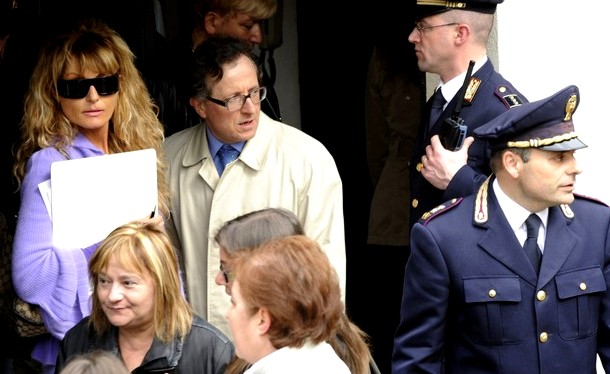
[The Supreme Court in Rome is expected later this year to confirm this outcome]

Wednesday, April 16, 2014
The Incriminating Bathroom Evidence: Visual Analysis shows the Footprint IS Sollecito’s
Posted by Machiavelli
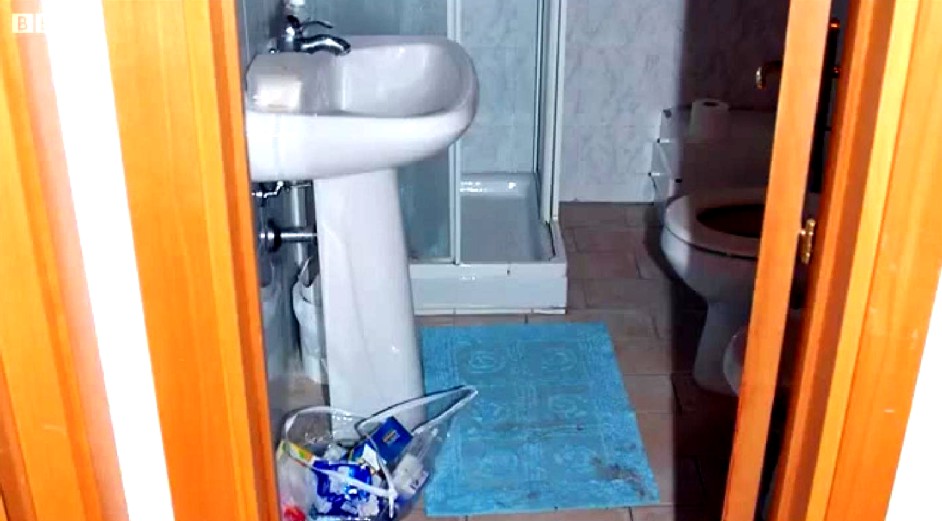
[Please click on each image for a larger and more high-resolution version]
The sheer depth and width of the hard evidence
The defenses really don’t want you to know this: in both width and depth, the full panoply of the evidence against Knox and Sollecito is absolutely overwhelming.
As we remarked in our post below there are far more and far stronger evidence points than UK and US courts normally require for conviction. But only the trial panel of judges observed anything like their full array.
The 2010 Massei Trial Report (which the Nencini Appeal court validated this past January) is a SUMMARY of what was presented to the judges in the courtroom. Those presentations in court were in turn something of a SUMMARY of the hard evidence buried in all the evidence files and the minds of witnesses.
Italian media SUMMARISED for Italians what was to be seen in the courtroom and to be read in the Massei Report. They were barely able to do even summaries for the 1/4 of all the trial hearings that were not open to the media or the public.
UK and US media for the most part didn’t even bother to provide comprehensive summaries (the very fine on-the-spot reportings of Andrea Vogt, Barbie Nadeau and Ann Wise were the main exceptions).
So in effect people in the UK and US attempting to follow the story didnt for the most part receive even a summary of a summary of a summary!
Not one US or UK newspaper or TV network translated the Micheli Report, or the vital Massei Report, or the Supreme Court appeal, or the Supreme Court outcome - only the (mostly professional) translators on PMF dot Org did all that translation.
This post is another example of how far down - beyond even Massei - it’s possible to drill into the evidence, and see it still hold up.
Some past posts on TJMK drilled down to similar depths, on the knives, on the DNA, on the mixed-blood traces, on the phone-events, on the motives and psychologies, and so on. All that evidence too all held up.
Visual analysis of the bathroom-mat footprint
This post mainly consists of high-resolution pictures and measurements. Presented like this, the pictures and measurements largely speak for themselves, and show the real strength of the bathroom-mat footprint evidence.
You will see that as SomeAlibi previously concluded using other methods, this footprint was quite undeniably Sollecito’s. It bears no similarity at all to Rudy Guede’s.
Please click on all images for larger versions in scalable PDF format
1 . [Below] the bathmat and the print, with measurement reference
2 . The bathmat print and the surrounding area
3 . The bathmat print (photo from Polizia Scientifica).
4 . The bathmat print, with vertical and horizontal sizes, from Rinaldi’s report
5. The bathmat print, photo with enhanced contrast.
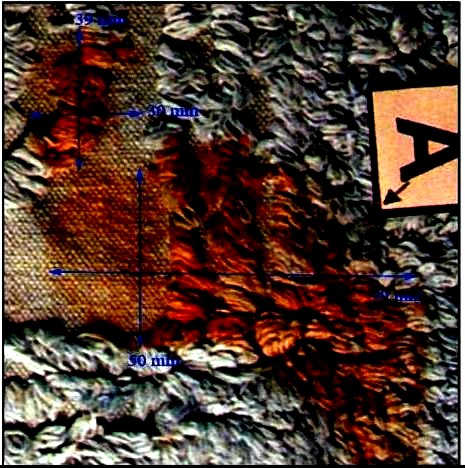
The photo above was modified by highly enhancing contrast.
6 . Enhanced contrast helps to spot some features
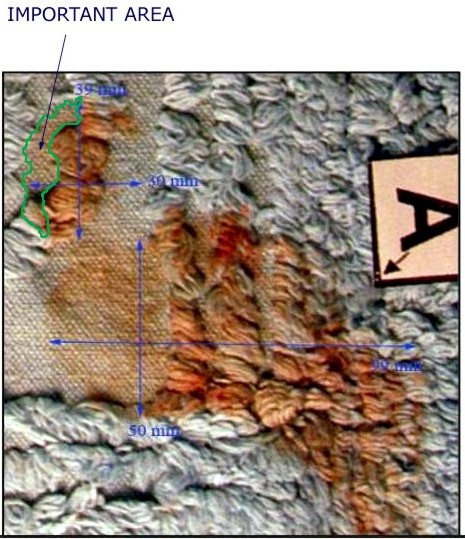
Contrast may help to highlight especially some parts of the print outline.
For example the area on the left labeled as “important area” in the picture (which was “forgotten” in the notorious photo elaborations disseminated by the ‘Friends of Amanda’ group), shows the actual left outline of the “˜big toe’ of the bathmat print.
The toe includes the area indicated in this picture (here the picture is shown again in its original colours).
7. The bathmat, with enhanced contrast
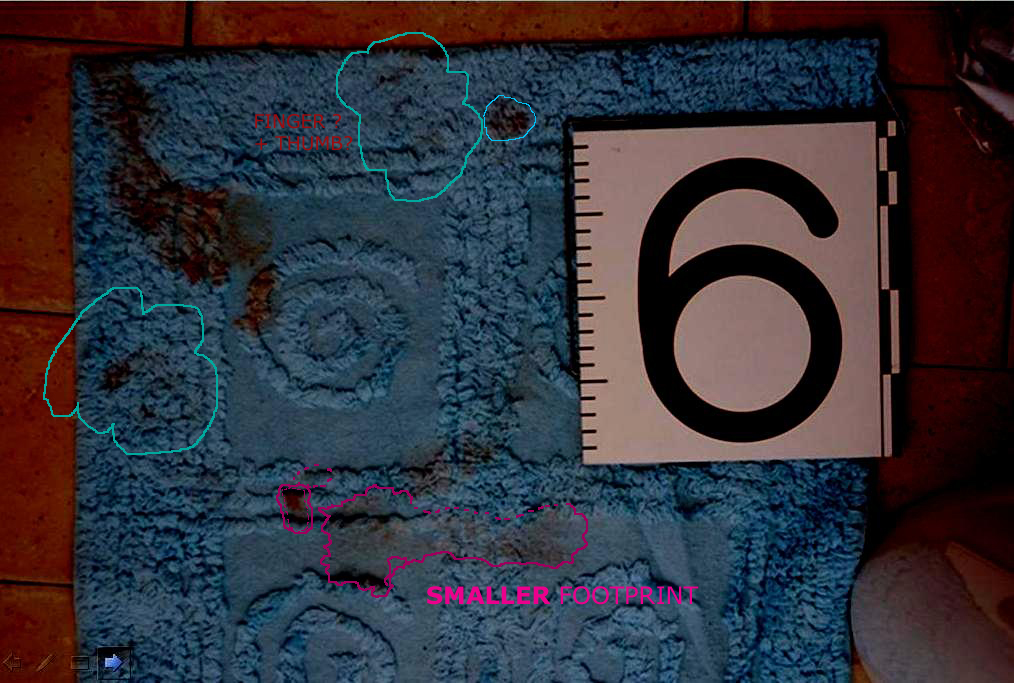
The contrasted image is showing the presence of other stains
There are other stains on the carpet (about another 10, factually situated in one half of the mat area), and also there shows a second diluted footprint (apparently from a foot of smaller size).
8. The selection of a set of red colour shades, outlined by an automatic outline generator
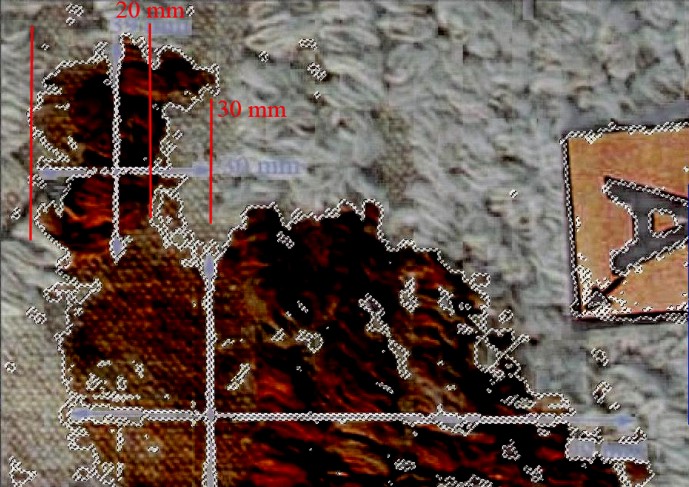
Shows the shape and the possible “˜outline’ of the stain
Reference measurements indicate the width of the “˜big toe’ in millimetres.
9 . A hand drawing of the outline (detail).
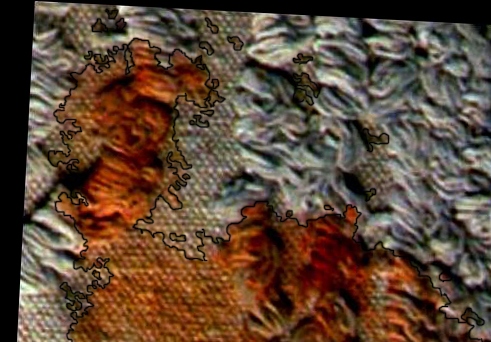
The photography above was modified
The modifications are: +28% contrast, -8% luminosity, + 20% colour saturation, from the original.
An outline has been drawn manually on the photoshop image, trying to be as faithful as possible to the actual stain.
You can notice that, apart from some minor “˜disputable’ very faint areas (such as the area between the toe and the metatarsus) there are only minimal differences between an automatically generated outline and a manually drawn one.
The shapes of the “˜big toe’ are extremely similar in both contours (images 8 and 9), in fact all meaningful features are basically identical.
We consider this manually drawn outline as good for comparison.
10 . The complete hand-drawn outline
11 . Minor detail: small dots separated from the main stain
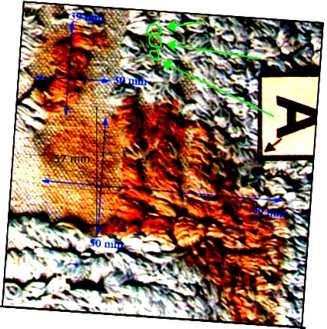
Observe the small red ‘dots’ in the picture above
Although we can’t draw any conclusion about their possible significance, we note the existence of these very small “˜spots’ of a faint red colour shade, separated from the big stain.
They are detected by the computer generated outline above, and that we also see as distinguishable with the naked eye thus we considered them in drawing manually the outline.
We don’t draw any conclusion about them; but because of their sensitive position (they may suggest a “˜small toe’ mark) we take note of them.
The green arrows in the picture point out their position (green circles).
12 . An image in electronically modified colours
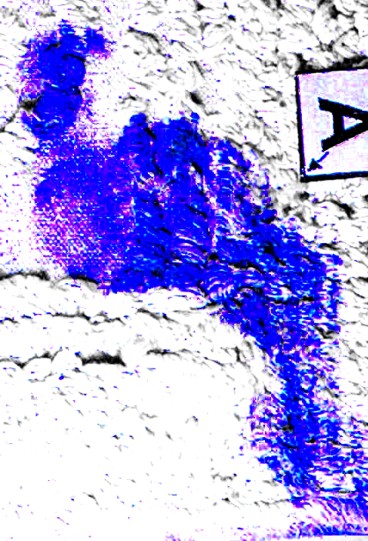
Distribution and intensity of the colouration
As a part of the preliminary study of the stain, we also produced this image above where the computer assigned an artificial colour to an array of shades of ‘red’, thus allowing to further isolate the stain from the background for further assessments about its shape.
This picture shows the distribution and intensity of the colouration. (note: the existence of some above mentioned tiny marks is recorded by this technique too)
13 . The bathmat has a spiral-shaped relief decoration
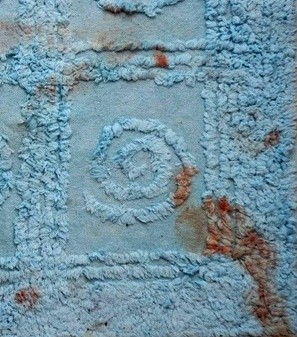
The footprint’s toe obviously balancing on top of the relief decoration.
We think the outline of the “˜toe’ mark of the bloody footprint is affected by the shape of the decoration, in particular the missing part of the toe on the right side, which is remarkably coincident with the margin of the decoration.
So that on that side there is a striking correspondence between the outline of the “˜negative area’ ““ the fabric surface around the spiral, which is lower ““ and the big toe’s outline
This indicates that the outline of that mark on that side was affected by the decoration margin, thus the print there has a “˜missing part’. So the “˜crooked’ bloody area in fact follows the margin of a larger toe.
Because of such coincidence, we can logically assume that the actual shape of the big toe mark appears to be part of a big toe, with larger surface which left its print only partly because part of its surface did not have contact with the fabric, in correspondence of the “˜negative area’.
14. The “negative area”
15. Mat decoration in relief and the toe mark
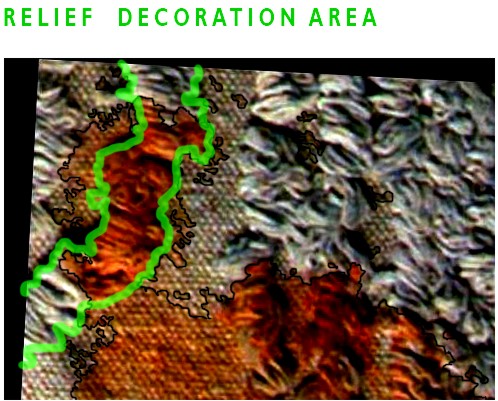
Observe above one single, unitary stain
The remarkable coincidence between the outlines of the decoration in relief and of the toe mark is shown in the picture above.
The rough contour of the print obtained through a smooth curve highlights the shape of the big toe.
Part of the relief decoration outline coincides with the toe mark outline, which shows, highlights and explains how all parts of the red toe mark, that you can see left of the relief decoration, they all belong to one single, unitary stain.
Thus we can deduce that the “missing” area on the right of the toe is determined by the decoration, and coincides with the negative area.
16. Picture (by Kermit) showing a rough shape of the stain
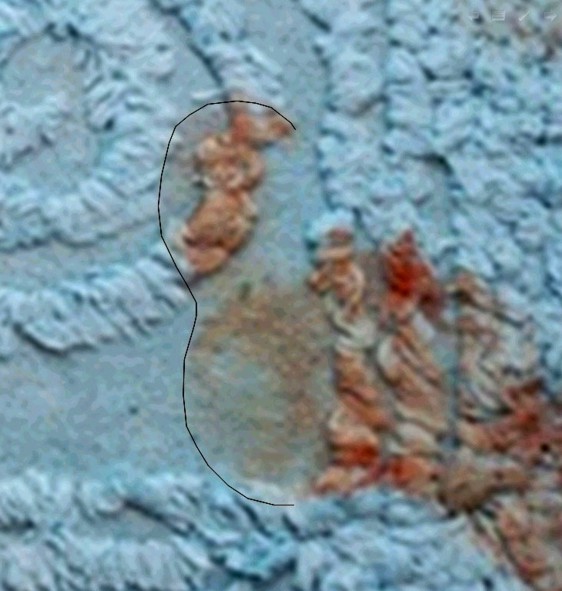
Observe shape, curvature and size
This drawing by Kermit above highlights the rough shape, curvature of left margin and overall size of the big toe.
17. Rudy Guede’s sample print
A copy of this picture together with one of Sollecito’s print at the same scale will be used for comparisons.
18 . Raffaele Sollecito’s sample print
A copy of this picture together with one of Guede’s print at the same scale will be used for comparisons.
19. Part of Rudy Guede’s sample print with Rinaldi’s reference measurements
20. Part of Sollecito’s sample print, with Rinaldi’s reference measurements:
21. Bringing all photographs down to the same scale
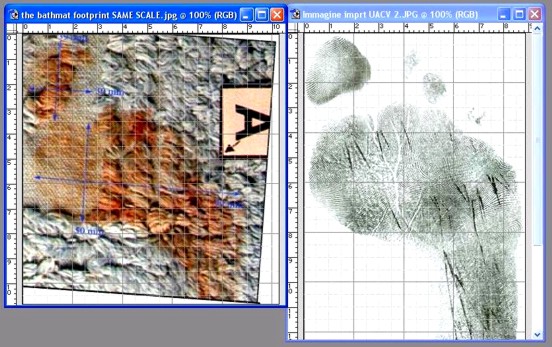
An accurate exercise of scaling was done
This was based on Rinaldi’s referenced pictures. Each one of the Rinaldi’s sample pictures has multiple measurements on several points of reference which allow a high precision determination of their scale and sizes, and thus comparison at the same scale.
In order to further increase scaling precision, the scale was calculated previously and separately for each comparative measurement in the three photos; this was done multiple times for each measurement and the average was picked in order to reduce error as for statistical measurement method.
The resulting final error in the scale is extremely small, far below a threshold of significance that could affect comparison (which was set arbitrarily at 1%, but it’s probably significantly higher, while the actual error is much lower).
In other words, the scale error that may affect your screen pictures will be definitely smaller than any possible perceivable (either significant or tolerated) difference that would be noticed or that may affect the attribution of the stain, when this is compared to the sample.
22. The hand drawn outline is shown again here
23 . The outline (matched scale) overlapped on Sollecito’s sample footprint
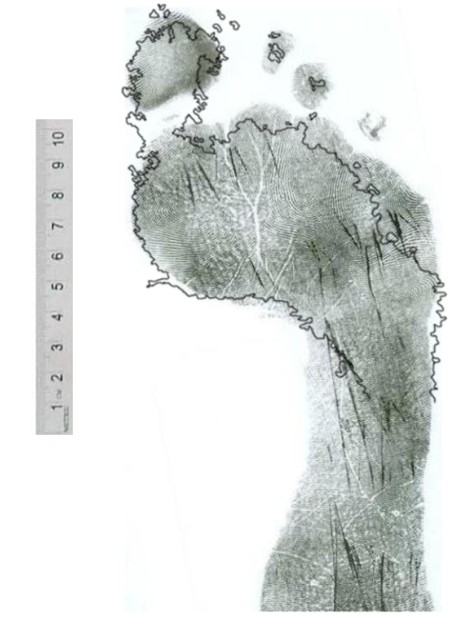
The array of compatibilities with Sollecito
The bathmat stain does not seem to have major incompatibilities with Sollecito’s print; it shows rather an array of compatibilities that can be perceived visually.
One interesting feature is the shape, size and position of a ‘big toe’, that appears as a remarkable coincidence; the toe also has a kind of cleft (see 28 below) on the curvature of its left margin. Another outstanding coincidence is the curvature of the plantar arch on the left.
24 . The same outline overlapped on Guede’s footprint
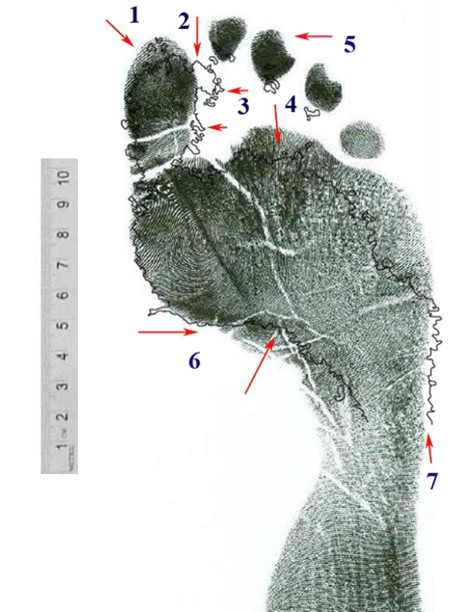
Compare with Guede’s - matched scale.
If you look at the overlapping of the stain outline (see pic 22.) with the sample of Guede’s print (see pics 17. 19.), you may notice 7 major differences, showing a failure of compatibility. Those differences are indicated by numbers (1-7) in the picture .
Each one indicates an area of major difference between the outline of the bathmat stain and the outline of Guede’s sample print. Those measurement differences are remarkably larger than those that can be detected on the overlapping with Sollecito’s sample print.
On the other hand, the compatibility between Sollecito’s print and some very peculiar aspects of the bathmat print (such as a 30mm wide and short toe) were absolutely remarkable.
The differences between the bathmat stain and Guede’s print are :
1) Toe mark of stain is significantly SHORTER than the big toe in Guede’s sample print (a difference of about 7 millimetres). Some people may want to attempt an objection, by suggesting that such a difference may be just a consequence of the position chosen for the overlapping, that maybe the bathmat print was just positioned too low in the picture, the problem may be solved by shifting it up about 7 millimeters so as to make the tip of the bathmat toe ‘coincide’ with the tip of Guede’s print toe.
However, such objection wouldn’t work; it’s a wrong argument. In fact the only possibly correct position for overlapping the bathmat stain outline is determined by the left curvature of the ball of feet and plantar arch (the area of the picture near number 6), which is by the way the most clearly outlined part of the bathmat stain. If you shift the bathmat stain upwards, the outline will miss the match with the curvature of the left margin of the ball of the feet. You will notice that the plantar arch in this area is already very incompatible with Guede’s plantar arch. It tends to become even more incompatible the more you shift the bathmat stain outline towards the toe.
The problem has no solution, since the more you shift the stain outline upwards (in the direction of the toe) in an attempt to make it look more ‘compatible’ with the length of Guede’s toe (or with an upper margin) the more it will become incompatible with the plantar arch. In order to limit the incompatibility of the plantar arch, and in order to keep an overlapping of at least the left margin of the ball of the feet, you need to place it as shown in the picture, this is the position of ‘maximum’ compatibility between the bathmat stain and Guede’s print. Conclusion: the bathmat toe is too short.
2) Toe mark of stain is TOO WIDE (30 mm). It is much wider (30 mm) than Guede’s toe. The number 2. indicates the protruding mark at the upper right, the mark which Giulia Bongiorno desperately insisted on calling a “second toe” mark. In fact, not only would the mark miss completely any hypothetical Guede’s ‘second toe’ in any possible position of the print; also you may notice (highlighted by pics 8. and 9.) how it is not a “mark” itself, but actually it just part of the same area which is entirely continuous in shape and coloration with the rest of the toe mark, and - the most remarkable feature - its right outline is coincident with the outline of the spiral-shaped relief decoration, so that you can reasonably conclude that it is determined by that (the missing area at the lower right of the ‘big toe’ is determined by the existence of the “negative area” of the bathmat decoration).
Conclusion: the bathmat stain has a wider toe mark, however one likes to call it (“big toe”, or “big toe + second toe”) that fails to match any possible part of Guede’s print. The bathmat print is clearly different and incompatible with Guede’s print. It simply cannot be overlapped to any part of Guede’s sample print. Such area is a very significant difference that points outright to incompatibility between the stain and Guede’s print.
3) The toe mark is larger also in the area located at the lower portion of the toe. The toe of the bathmat print in fact has a ‘right margin’ which actually has some additional small marks, small drops protruding towards the right, like droplets maybe produced by the wet cotton fibres of the part in relief which protrude towards the right. This tends to suggest the toe area of the stain may in fact be considered wider: the object that produced it was definitely wider than 22mm, in this area of the toe as well. So also a look at this area confirms that the bathmat stain is wider than 22-23 mm (more towards 30 mm) not just when measured at the upper corner (number 2.) but also at its “lower” parts; here, the small marks caused by the liquid suggest that a larger surface has squeezed liquid from some fabric threads leaving some trace also on the lower area.
4) Bigger incompatibility of Guede on the metatarsus front outline. This area is the front outline of metatarsus: the stain is almost 1cm shorter than Guede’s metatarsus. This happens when you chose the overlapping so as to make the left outline and plantar arch (6.) of metatarsus coincide, as in the picture. Sollecito’s sample print also shows some difference from the stain in this area (pic. 23.) but the difference between the stain and Sollecito’s print is significantly smaller than what you can see in Guede’s print.
5) There are NO SMALL TOES in the bathmat stain. Small toes are completely absent from the bathmat stain (while the tiny blood marks around the stain don’t coincide with their expected position if it was Guede’s print). Such lack of small toes is a peculiarity of the bathmat print. This is a remarkable difference from Guede’s print, and at the same time, a considerable analogy with Sollecito’s print. In fact one outstanding feature of Guede’s print is the evidence that Guede places a big load of weight on his small toes while instead Sollecito has a posture with a weight distribution with the contrary tendency, and obviously he almost does not touch the ground with his small toes.
Thus, Guede’s small toes are all very well pressed on the ground and thus, we can reasonably infer they are somehow naturally likely to get wet if he steps on any wet surface, and anyway they should get wet for sure if the foot is immersed in water or washed (the foot that left the bathmat print must have been immersed in bloody water). The murderer supposedly washed his foot then stepped on the bathmat. In order to attribute the print to Guede we should assume that Guede “forgot” to touch the carpet with his small toes (while instead he puts a lot of weight on them) or that he managed to not rinse them.
6) The outline of the stain has a PLANTAR ARCH that COINCIDES, by curvature and angle, with the plantar arch in Sollecito’s print, while instead it is very different from the plantar arch of Guede’s print.
7) The stain is larger than Guede’s print metatarsus as visible in the right area of the stain. The difference is rather significant, almost half a centimetre, that is bigger than the difference with Sollecito’s print which instead coincides for a trait. This difference cannot be “solved” in any way since, even if one wanted to claim that the scale is wrong and that the stain should be sized down, this would make the toe, already too short (as in 1.) become even shorter.
If instead the toe length is adjusted the metatarsus becomes even less compatible with Guede. We recall that Massei found that Guede’s feet had a print overall more slender than Sollecito’s.
25 . Other features:
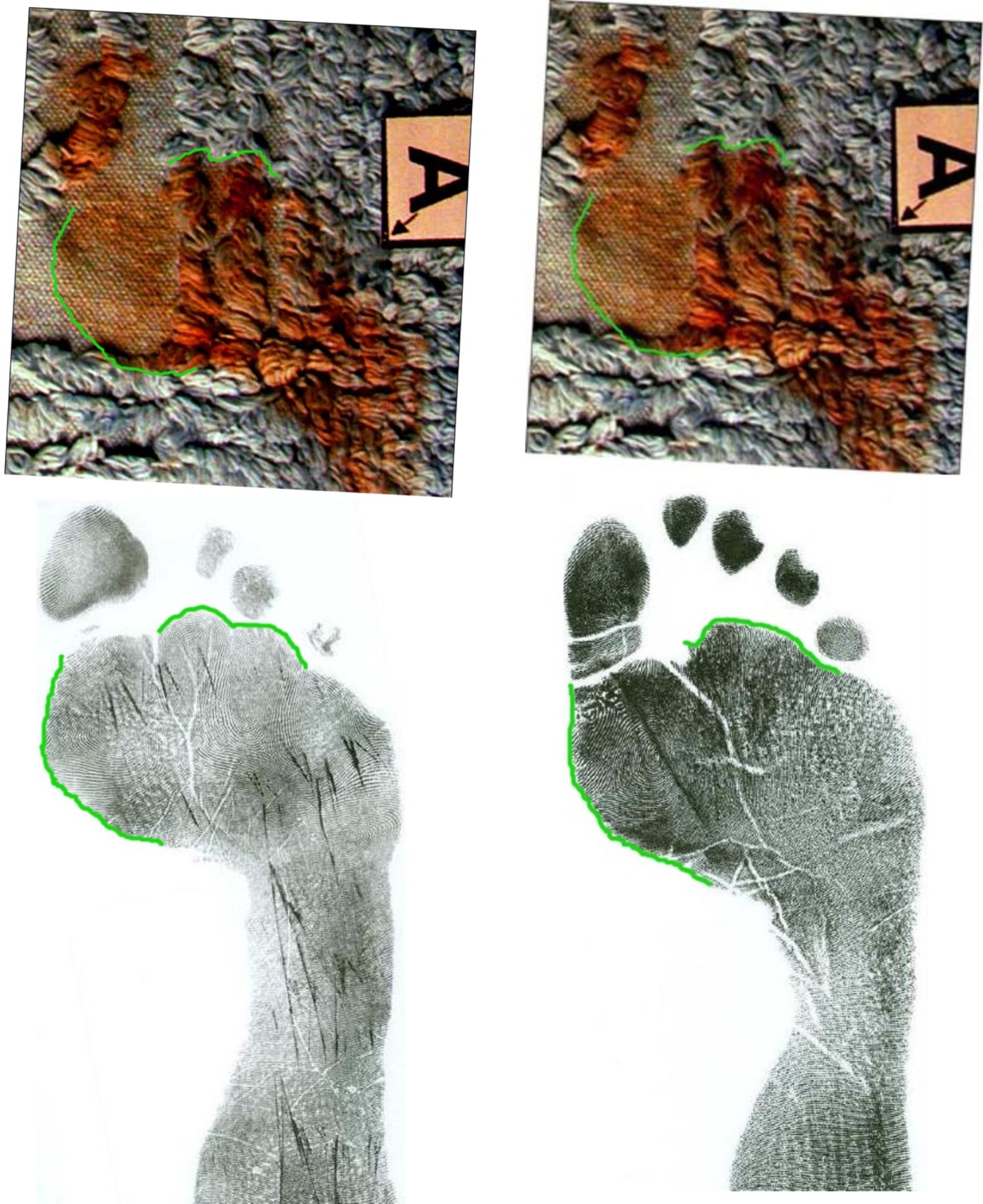
Curvatures of plantar arch are very different
The plantar arch curvature, highlighted in two different drawings (the second highlights also the upper outline “hunches”); the plantar arches in the two sample prints of Sollecito and Guede are shown below. The curvatures of plantar arch are very different.
26. The outline curvature generates different angles
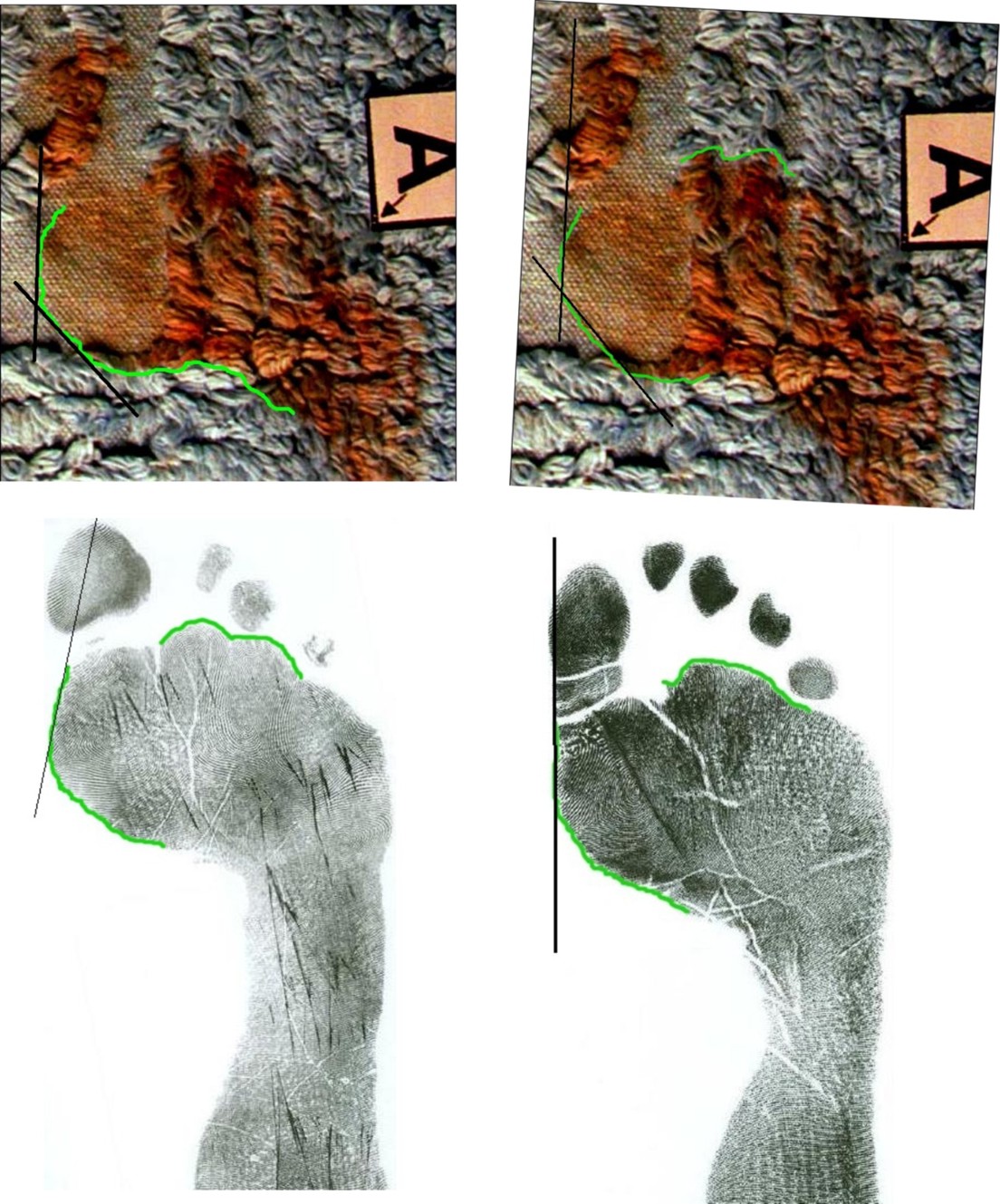
Sollecito’s and Guede’s plantar arch curvatures have very different angles. Also the left outline of metatarsus maintains a different curvature. Sollecito’s outline has an angle (see outline tangent) intersecting the toe (the metatarsus has a “bunion”); in Guede’s print there is basically no intersection, the outline and the toe form almost a straight line.
27 . Plantar arch curvature angle differs between Sollecito and Guede
If you consider the vertical axis of the sample footprint, and its orthogonal line, you may notice how the plantar arch curvatures of the two prints accomplish different angles: the two angles are VERY different, not just three or four degrees.
The (too) narrow angle of Sollecito’s plantar arch probably has a relation with the protruding outline and angle seen in pic 26., and seems related to a hallux valgus (which Guede does not have).
28 . The “cleft” on the left side of the stain
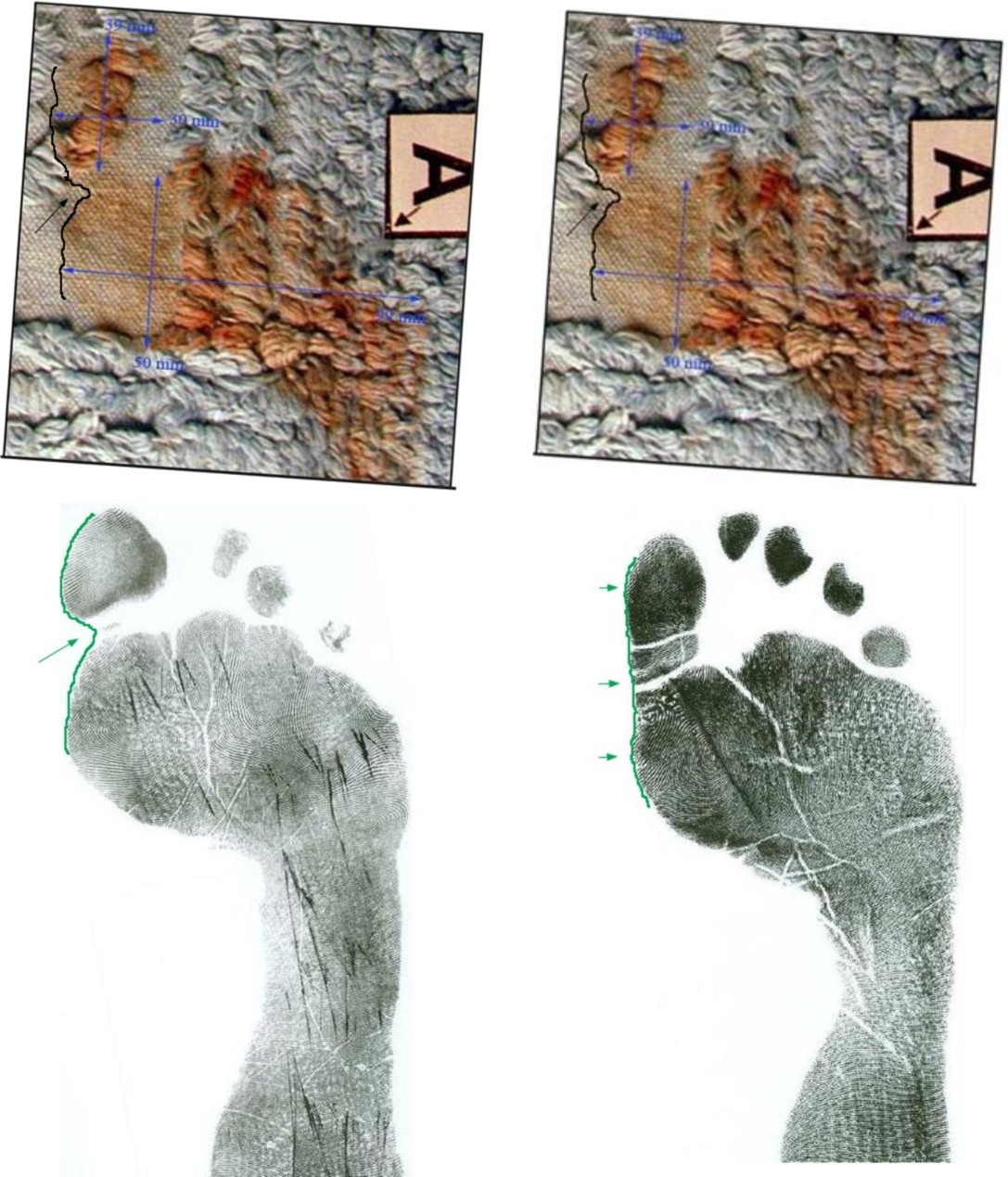
The “cleft” on the left side
This has a correspondence with one sample print, not so with the other.
29 . Table of metric comparison (by SomeAlibi)
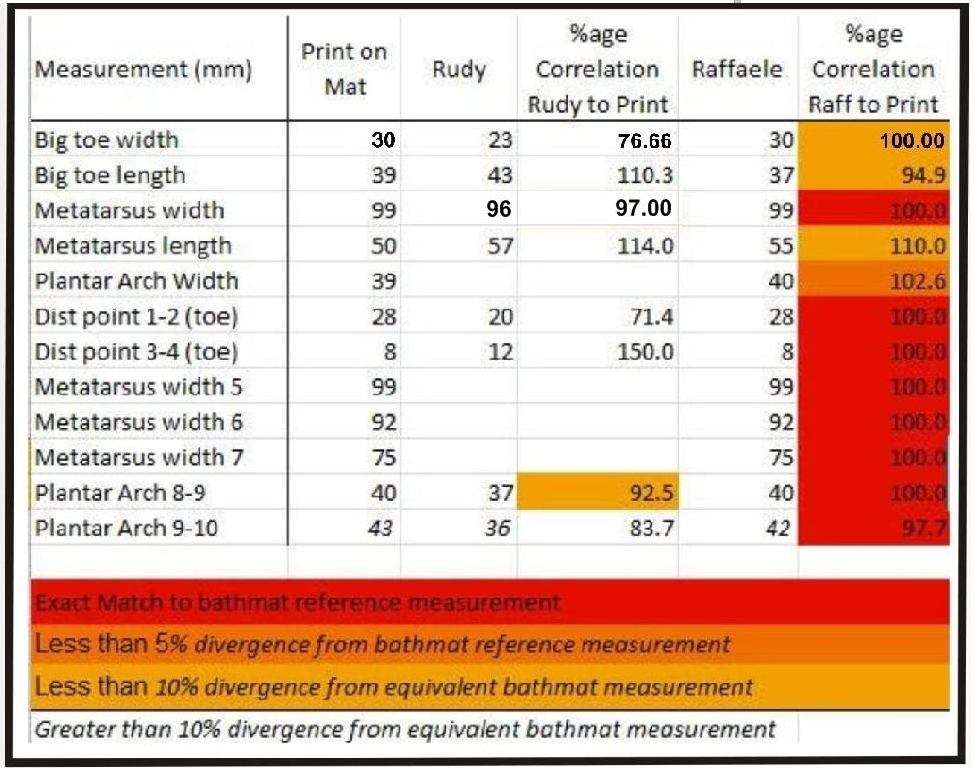
SomeAlibi’s post of a year ago
Comparison of measurements and analysis of correspondence degree of bathmat print, with both Guede’s and Sollecito’s sample prints.
Monday, February 03, 2014
Authors Of “Math On Trial” Bring The Explanations Of The Hard DNA Evidence Up To Date
Posted by Peter Quennell
The important new book in question Math On Trial is by mathematicians Leila Schneps and Coralie Colmez who is Leila’s daughter.
This article by Leila Schneps appeared in yesterday’s edition of The Independent and explains why the Nencini court has not ruled out any of the DNA evidence.
It’s not right to say there is “˜no evidence’ in the case against Amanda Knox. There’s plenty
The DNA alone is enough to raise questions
The verdict handed down yesterday at the new appeal trial for Amanda Knox and her former Italian boyfriend, Raffaele Sollecito, accused of the murder of British citizen Meredith Kercher in Italy in November 2007, may come as a surprise to those whose view of the case has been affected by an international media blitz based on the oft-repeated claim “There is no evidence”. Many believe that Rudy Guede, convicted in October 2008 for participating in the murder, acted alone.
There is, however, copious evidence to consider: the DNA alone is enough to raise questions. Leaving aside much of it, let’s focus for a moment on three key pieces of DNA evidence and present them from both sides, just as the jury may have heard them spoken of in court.First ““ the bra clasp.
The part of the victim’s bra containing the hooks had been ripped or slashed from the rest of her bra. Not immediately collected on that first day after the murder, it remained in the room in a sealed house for six weeks before being sent to the lab in December. There, it was tested and found to contain a large sample of Meredith’s DNA, together with a smaller but clearly visible contribution from Sollecito. The defence objections: firstly, between the two searches, objects in the crime room had been moved around, and indeed the bra clasp was found about a metre away from its original position.
Secondly, apart from “˜alleles’ - genetic traces - of Meredith and Sollecito on the clasp, there were a few unidentifiable extra ones. Putting these two facts together, the defence pointed out that Sollecito’s DNA on the bra clasp could have been a consequence of a careless police technician stepping on Sollecito’s DNA elsewhere in the flat and then entering the room and stepping on the bra clasp, even though no DNA of Sollecito was found anywhere else in the house except on a single cigarette butt in the ashtray.
Second ““ the mixed stain.
Although not visible to the naked eye, the chemical Luminol which flashes blue on contact with blood revealed a spot in the room of the flatmate whose window had been smashed and room rifled. Swabbing the spot produced a mixture of Amanda and Meredith’s DNA. This is a clear proof that the murderer entered that bedroom after the murder, as someone must have brought Meredith’s blood into the room, contradicting the defence theory that Rudy Guede broke into the house and then committed the murder.
The usual defence explanation for mixed DNA stains in the bathroom and corridor, namely that the house would have been coated in Amanda’s DNA given that she lived there, does not necessarily apply to a flatmate’s bedroom. It is much harder to leave traces of DNA than is commonly conceived, and hardly any of Amanda’s DNA was found in her own room - where she surely spent a lot more time than in her flatmate’s.
Lastly ““ the knife.
Days after the murder, a large kitchen knife was seized in Raffaele’s flat, where Meredith had never set foot. Police geneticist, Patrizia Stefanoni, swabbed spots on the blade of the knife and on the handle in the knife’s first DNA Test. One spot in particular attracted her attention: a visible scratch on the flat of the blade. The swab taken from this scratch yielded a positive ID for Meredith Kercher.
By the third trial, when a new attempt was made to collect DNA from the knife (which had been swabbed again during the appeal trial, though no tests were then conducted) there was no match to Meredith ““ a result welcomed by Knox’s defence team, though it did not in fact impact on the findings of the first trial.
Stefanoni’s test ““ she only conducted the first - came under strong fire in the courtroom. Two independent expert witnesses called in for the appeal against Knox and Sollecito’s original 2009 conviction stated that she had not worked in conformity with standard international protocol. Indeed, standard protocol for DNA testing involves three steps: first determining how much DNA is in a sample, secondly amplification, which reproduces the sample millions of times, and thirdly electrophoresis which produces the familiar DNA graphs showing peaks in the location of an individual’s alleles. Under cross-examination, Stefanoni explained that quantification had given a result of “too low” as the machine she used that day was not the most sensitive one in the lab.
Knowing that samples undetectable by the machine can still be sufficient to yield positive results, she chose to continue with testing. At the second stage of testing, amplification, a sample will normally be split into two or more pieces in order to run independent tests. But knowing that the sample was small, Stefanoni feared that cutting it in two would yield no result at all, and chose to amplify the entire sample in one unrepeatable test. The end result was a perfect match to Meredith Kercher.
Knox’s supporters have claimed since the beginning that the accusations levied against her are based on the Italian justice system’s hatred of a pretty, American girl who likes parties and having sex. And whilst both parties protest their innocence , Thursday’s decision shows that there is real evidence against her and Sollecito, that cannot be ignored.
Wednesday, January 29, 2014
Continuing Enormous Strength Of The Evidence Which Defenses Seem To Have Abysmally Failed To Shake
Posted by Our Main Posters

[Above Judge Massei at Meredith’s house with panel-of-judges members early 2009]
What this Florence appeal is REALLY about
There is much confusion on this, sowed by various at-distance commentators who don’t read the Italian press or the excellent English-language reporters right there on the spot.
This is NOT a re-trial. This is a FIRST appeal by Sollecito and Knox against the guilty verdicts and sentences Judge Massei awarded them late in 2009. It is being repeated since their defense teams helped to bend the first (Hellmann court) iteration of the first appeal two years ago.
Since the end of 2009 they have been provisionally guilty of murder and other crimes, subject to final ratification by the Supreme Court, which has not yet occurred. Judge Hellmann decided to let them out and travel worldwide. Many think his decision on this was legally weak.
Was there prime-face justification for this appeal?
Under US and UK law many lawyers and judges think the judicial process could have stopped right there in the US and UK, because the grounds for appeal the defenses came up with in 2010 were essentially innuendo about DNA and little else.
But the pro-defendant Italian system unlike almost any other in the world allows appeals if any are filed to automatically go forward. So the bent, stretched-out and illegally wide-scope Hellmann appeal of 2011 was the first result.
Appointed apparently in illegal circumstances to replace the highly-qualified Judge Chiari (the lead-judge for criminal appeals, who then resigned) Judge Hellmann was ill-qualified at best - he was not a criminal judge and had handled only one other murder trial before, which he got wrong.
The annulment of the first first-appeal
The Supreme Court very rarely completely annuls any trial or appeal. But in this case in March 2013 it did just that, on a large number of grounds.
The 2013-2014 Nencini appeal court in Florence starts with the early-2010 Massei report plus new guidelines from the Supreme Court. Nothing else floated since early 2010 counts.
This case seems to break all records ever for (1) defamatory and dishonest PR; (2) dirty tricks, many illegal, by the defense; (3) dishonesty by those accused in two defamatory books and multiple statements to the press; and (4) greed and blood money while the process still goes on.
Contempt of court trials and investigations have commenced to push back, Amanda Knox is particularly at risk because her book contains false accusations of crimes (again) and she defies the Supreme Court in not paying Mr Lumumba his damages though she destroyed his business.
Suggested Reading: Part One
Sooner or later (no necessarily now) read all the must-read posts in this group here, all the open questions for Sollecito in this group here, and all the open questions for Amanda Knox in this group here.
1. Getting up to speed on the 2008 RS and AK charges
Our four-part summary of Judge Micheli’s report is the best thing to read (scroll down) especially Micheli’s argument that ONLY Knox had any reason to re-arrange the crime scene - she lived there and needed to point evidence away from herself.
Also read Amanda Knox’s and Raffaele Sollecito’s many mutually contradictory attempts to provide one alibi for both.
2. Getting up to speed on the 2009 RS and AK trial
The prosecution performed brilliantly and left the defenses despondent and out-classed (paving the way for more dirty tricks in 2010-13) and we were told that two defense lawyers nearly walked off.
To get a flavor of how badly the defenses did, read this post and this post on Knox’s absolutely disastrous stint on the stand. From there the defense portion of the trial really went downhill.
To get a flavor of how well the prosecution did read about the damning reconstruction (known about in all of Italy but not widely elsewhere) described here and here.
3. Getting up to speed on the Massei 2010 Report
The most vital read of all is the short-form version of the Massei Report by Skeptical Bystander and a team on PMF dot Org. If you have no time to read any posts, make sure to read that.
The other vital reads, not here but on the new “The Murder Of Meredith Kercher Wiki”, are the overview of the evidence and the chart of evidence synopsis.
We had a large number of posts starting in 2010 checking out whether in all details the Massei Report got it right. Read this first take.
4. Getting up to speed on the crime-scene scenario
Vital to understanding the Massei court’s crime-scene scenario which Prosecutor Crini espouses, wade through this excellent reconstruction of the crime in a long Powerpoint by our lawyer James Raper with the Powerpoint whizz Kermit.
About Part Two
The next part of our most-recommended reading from 2010 to 2014 will follow after the verdict to help correct the ill-informed debate over whether Knox goes back to jail.
It hardens the case and in our view leaves no holes for RS and AK to wiggle through. We will point the post to those arguments that anyone tries to raise.
